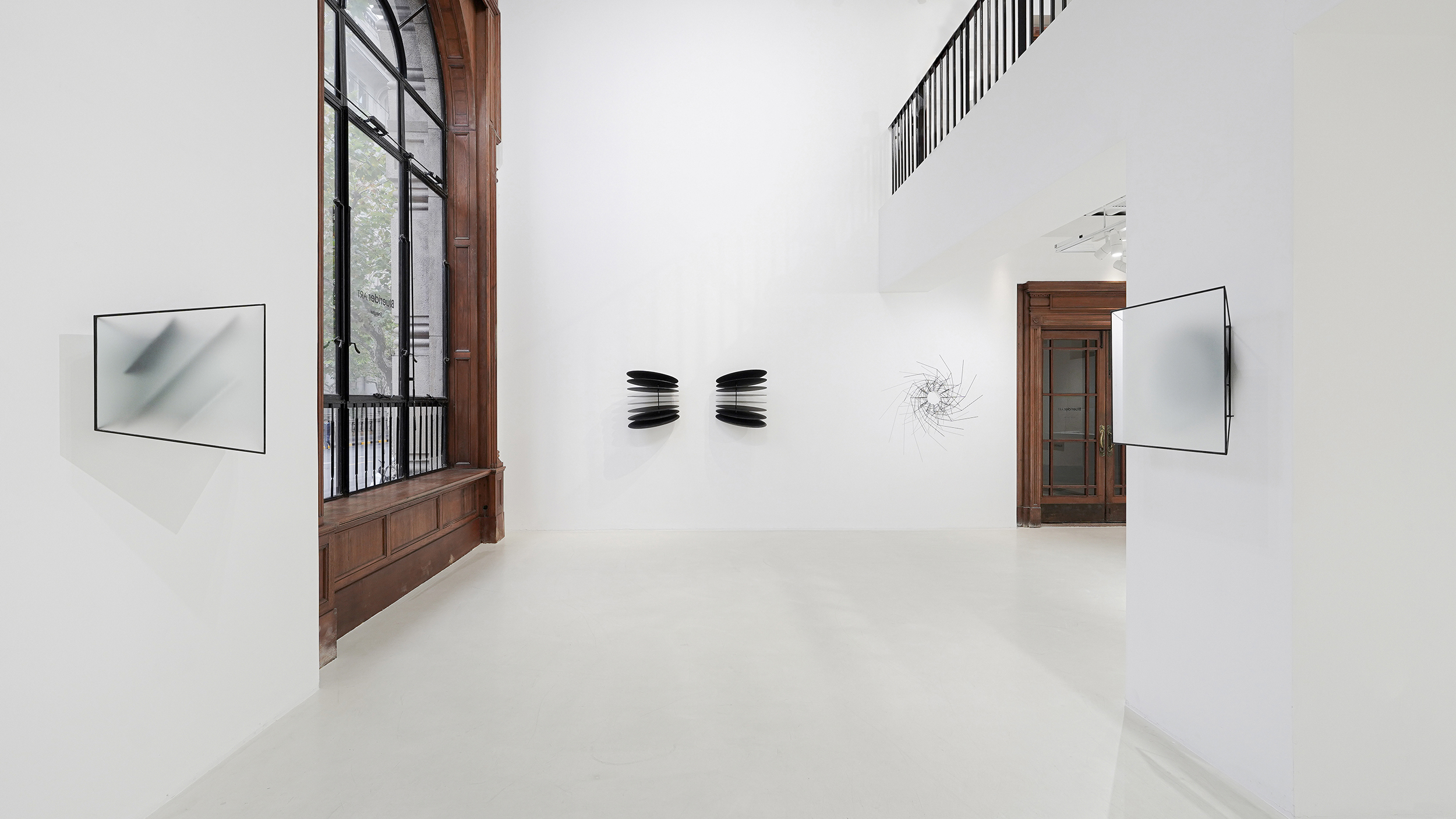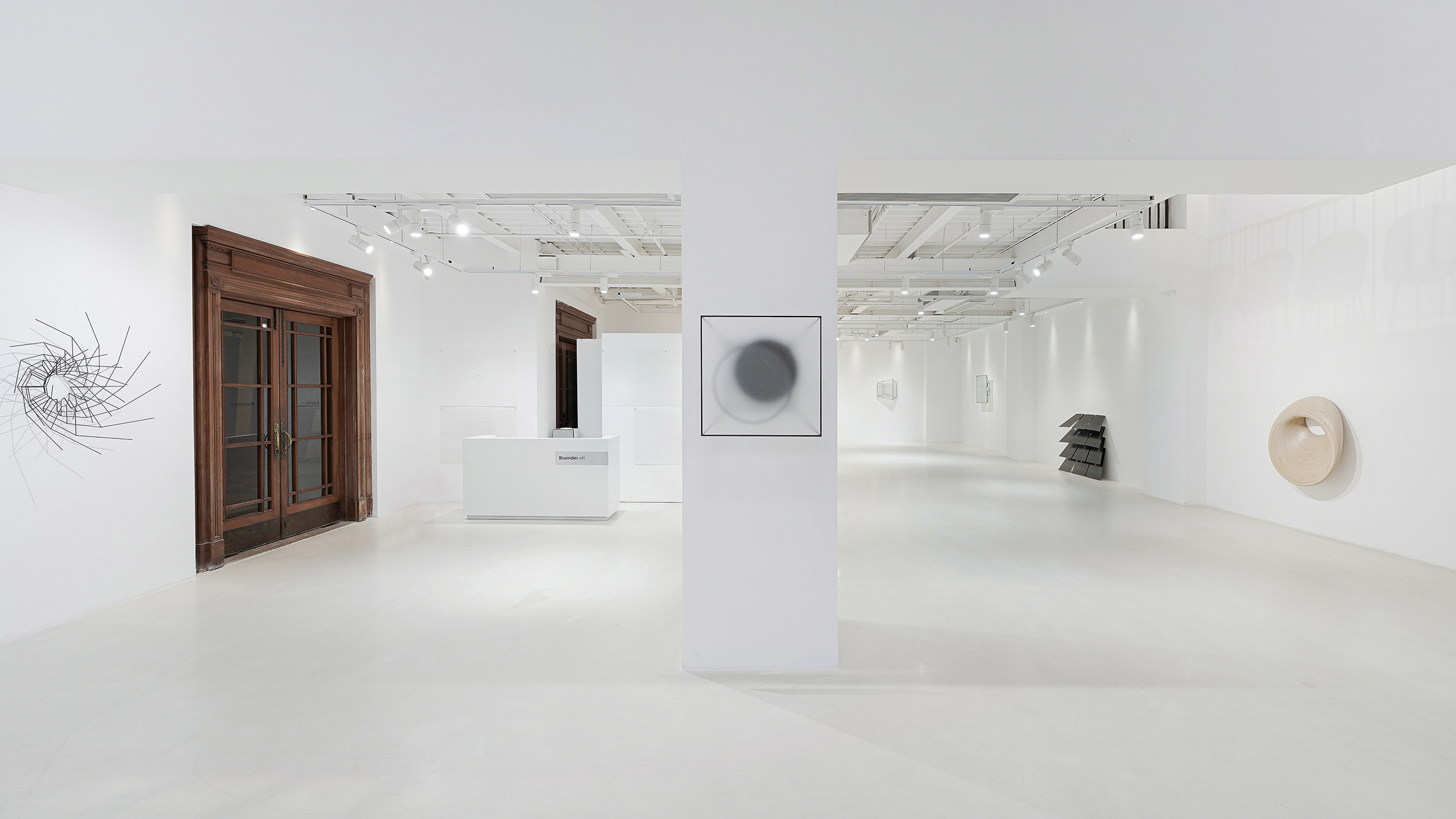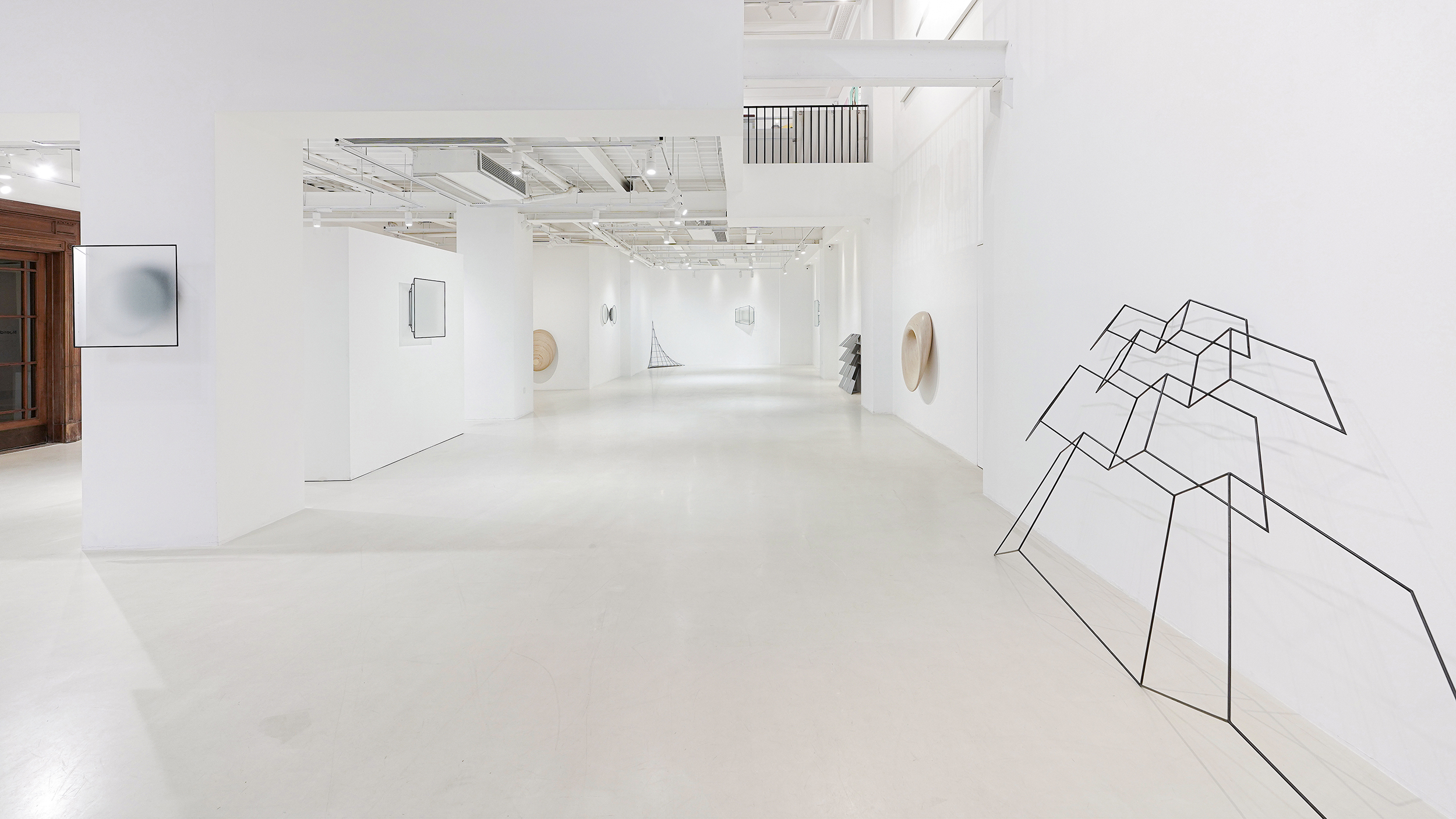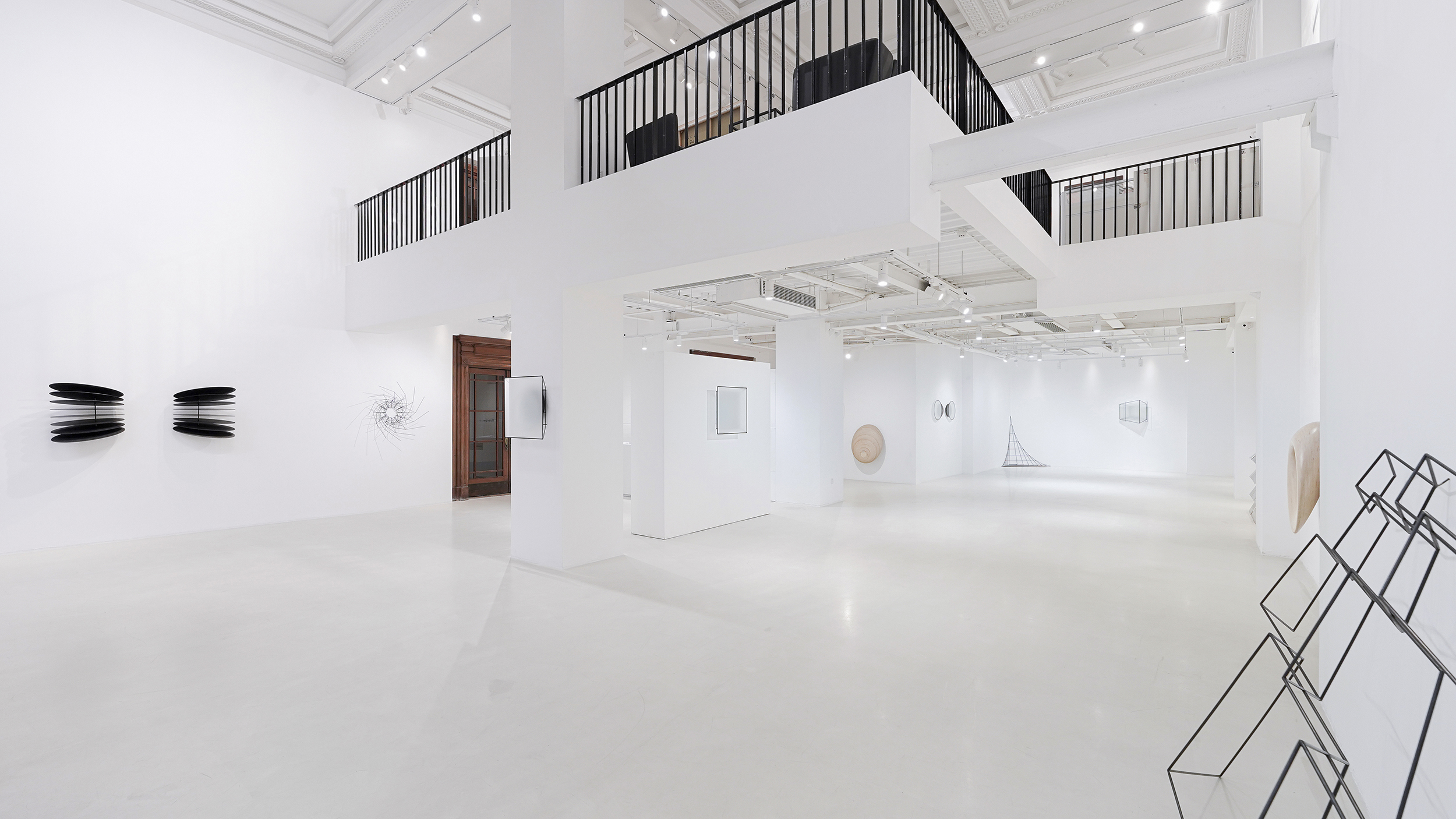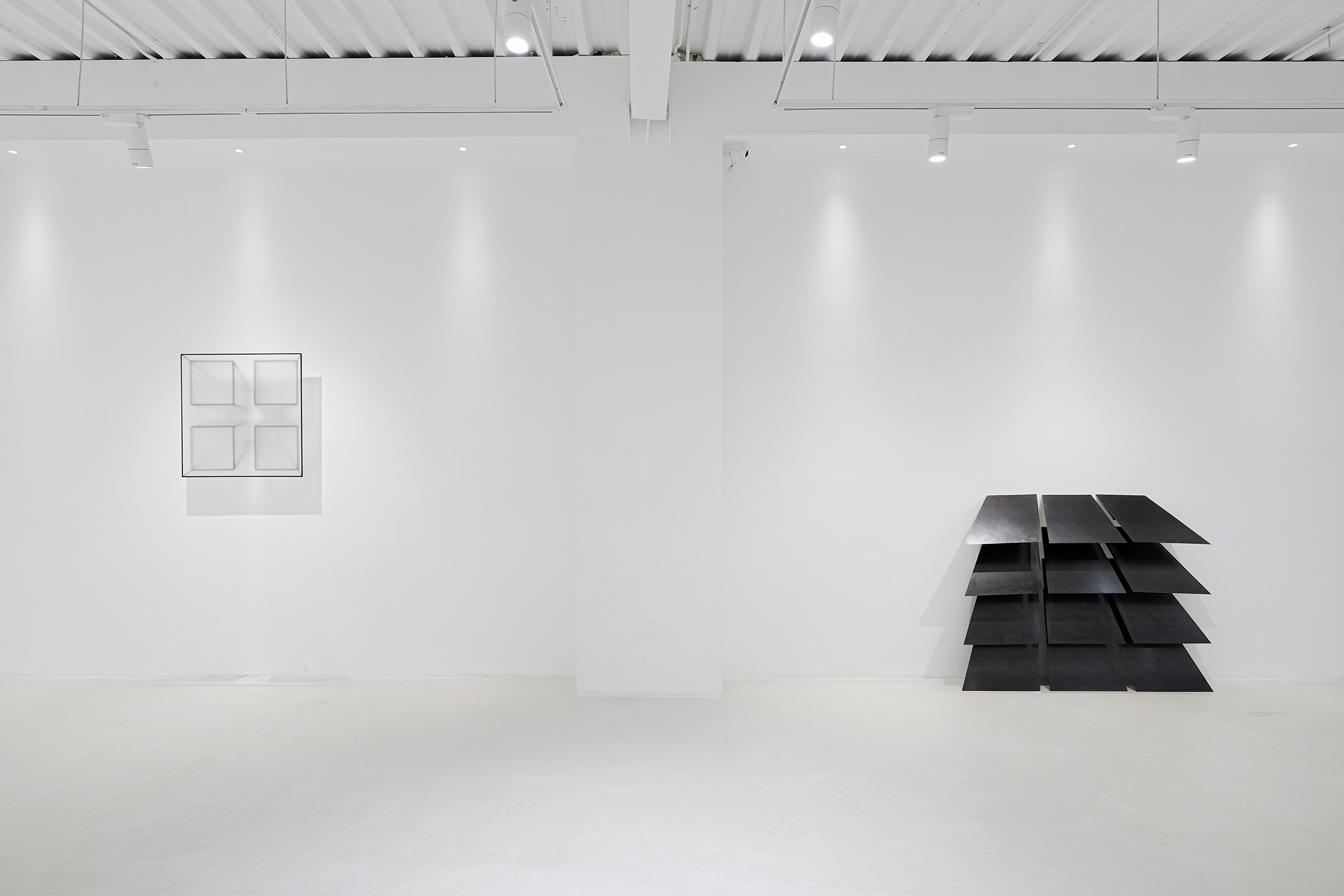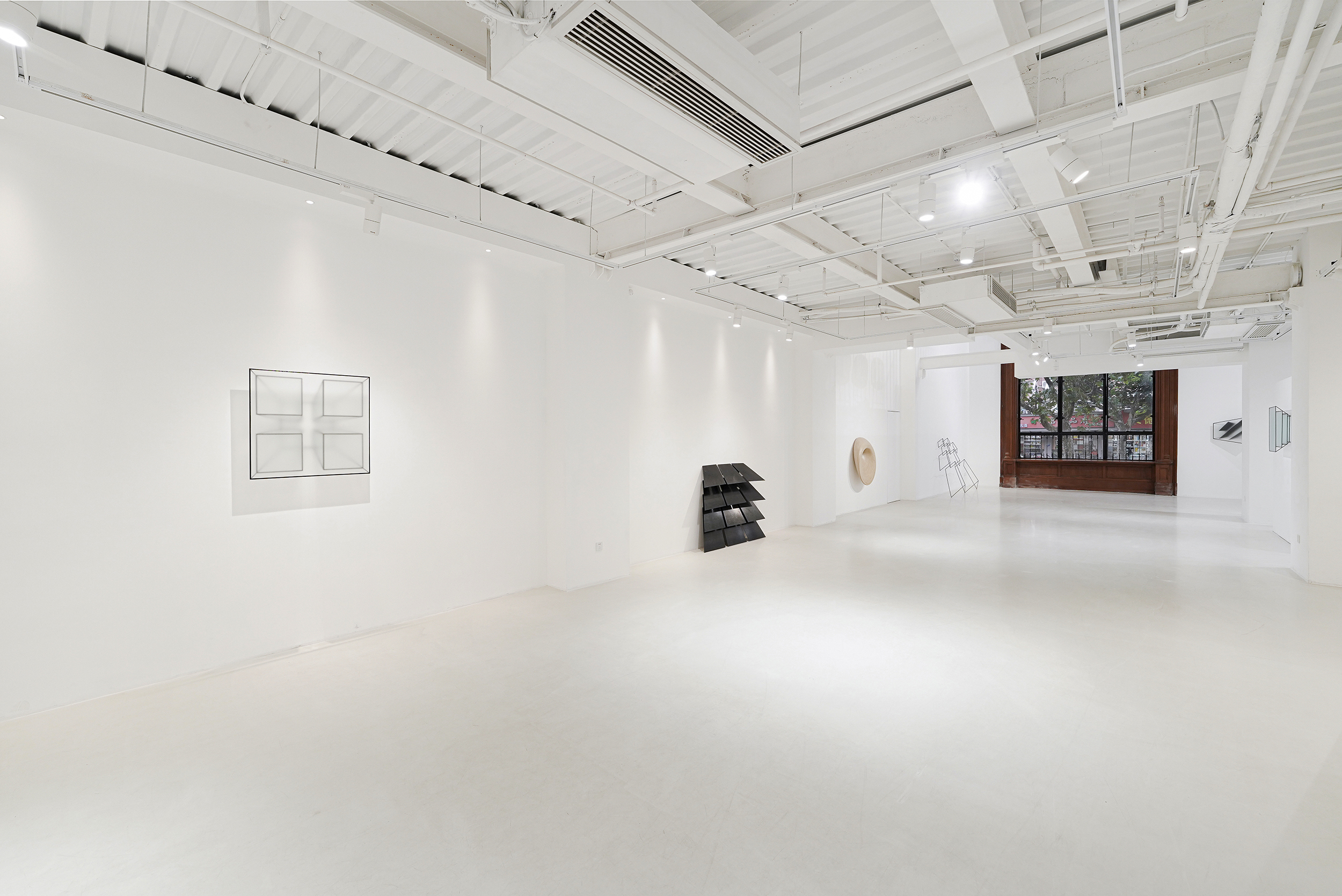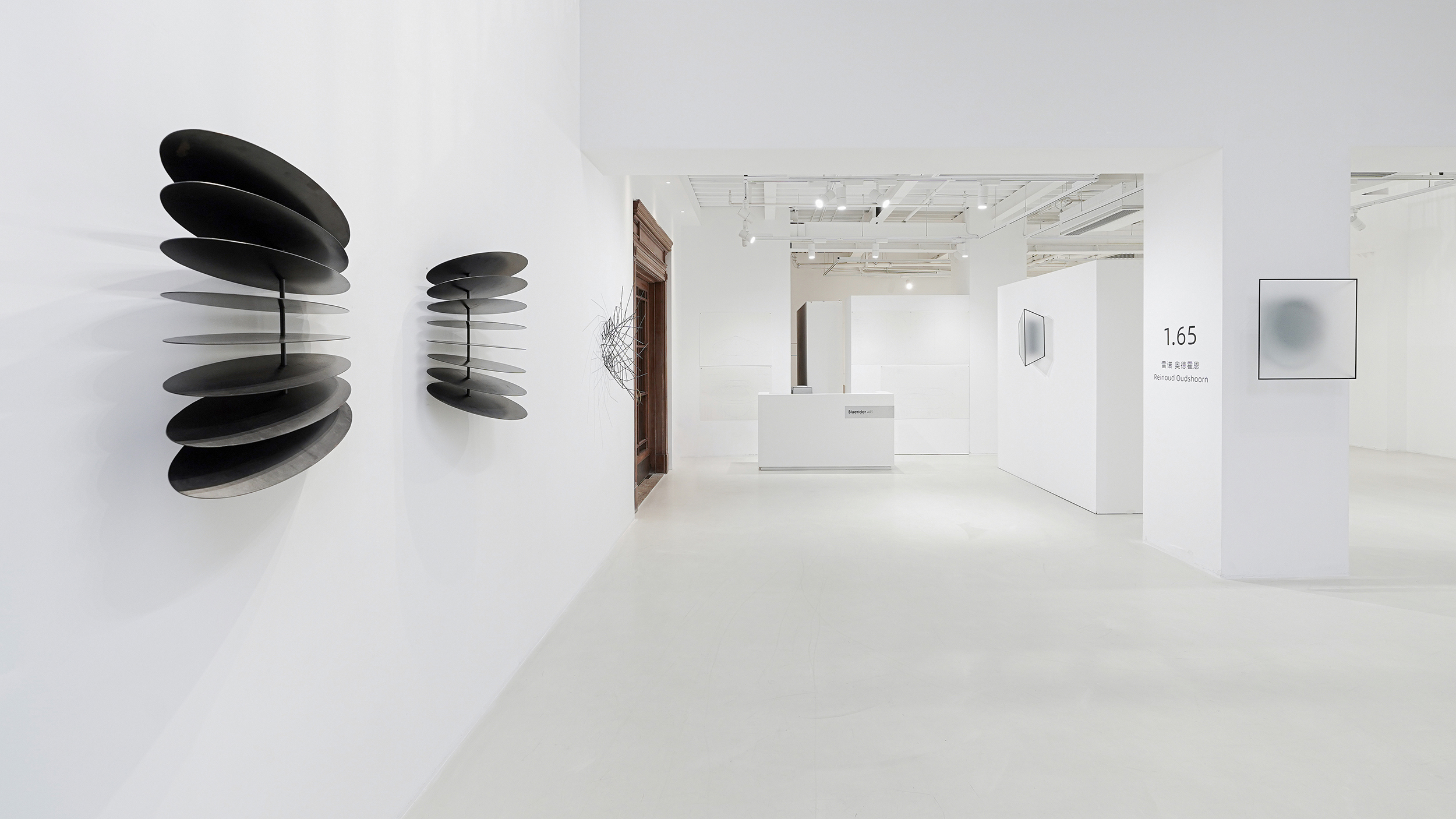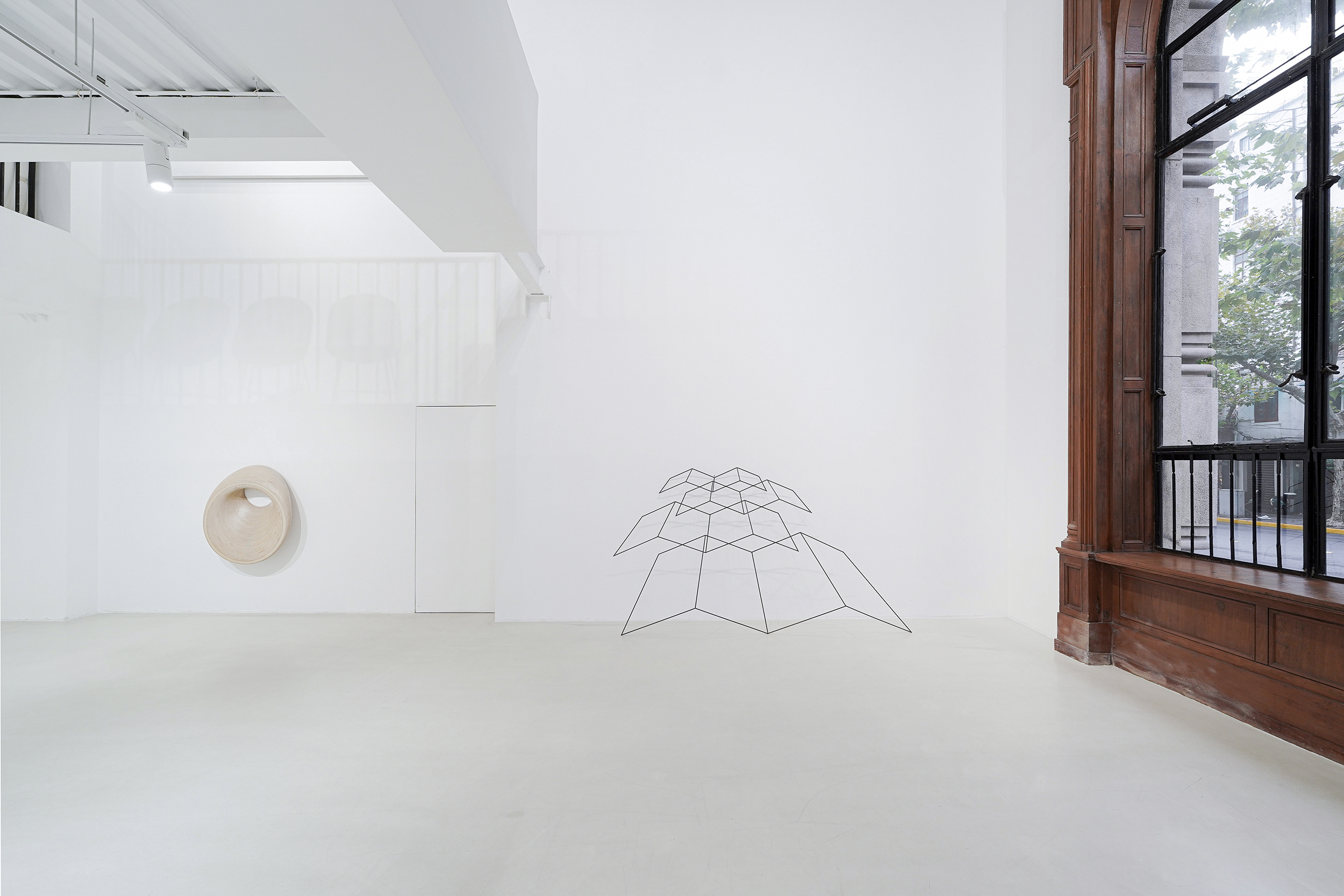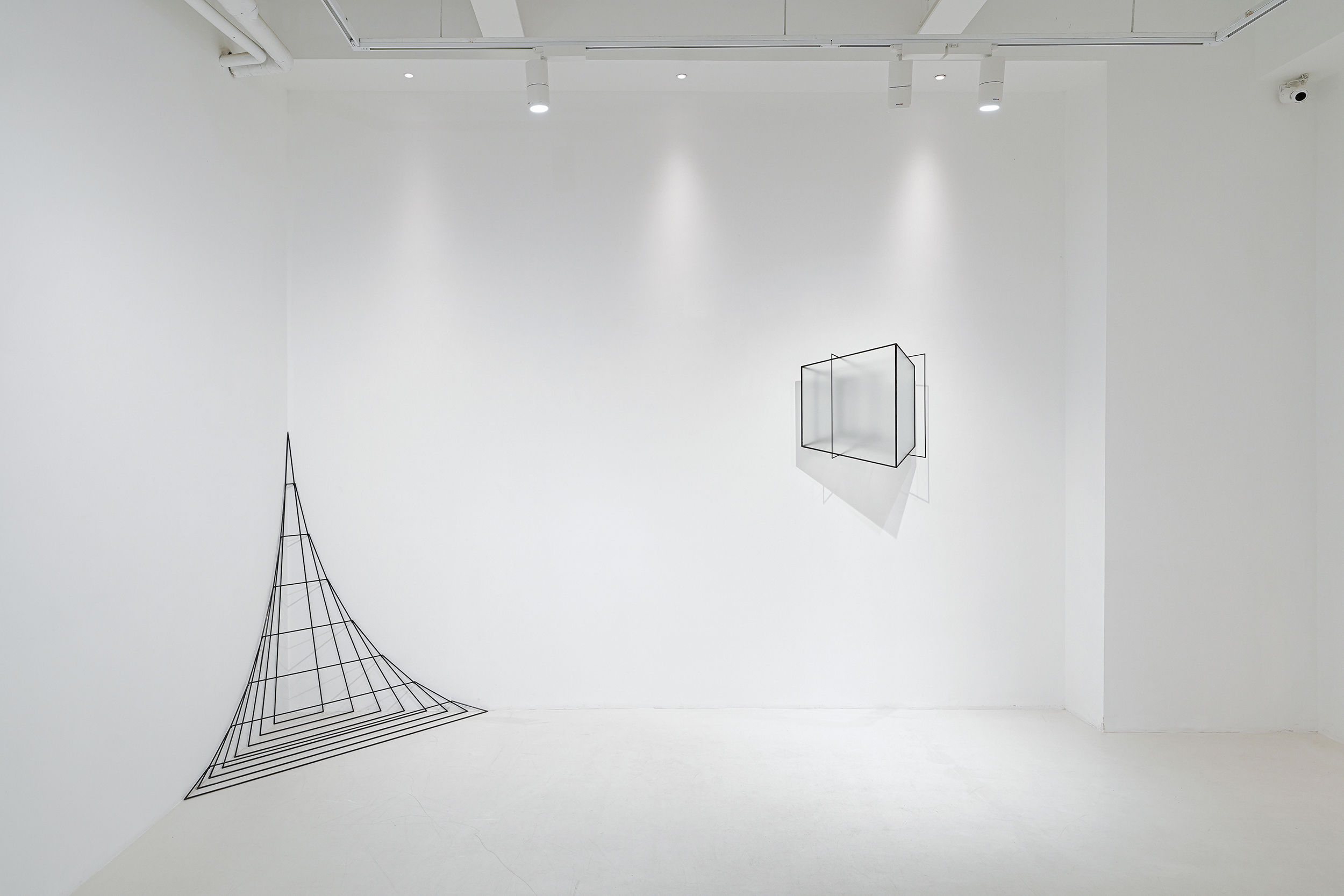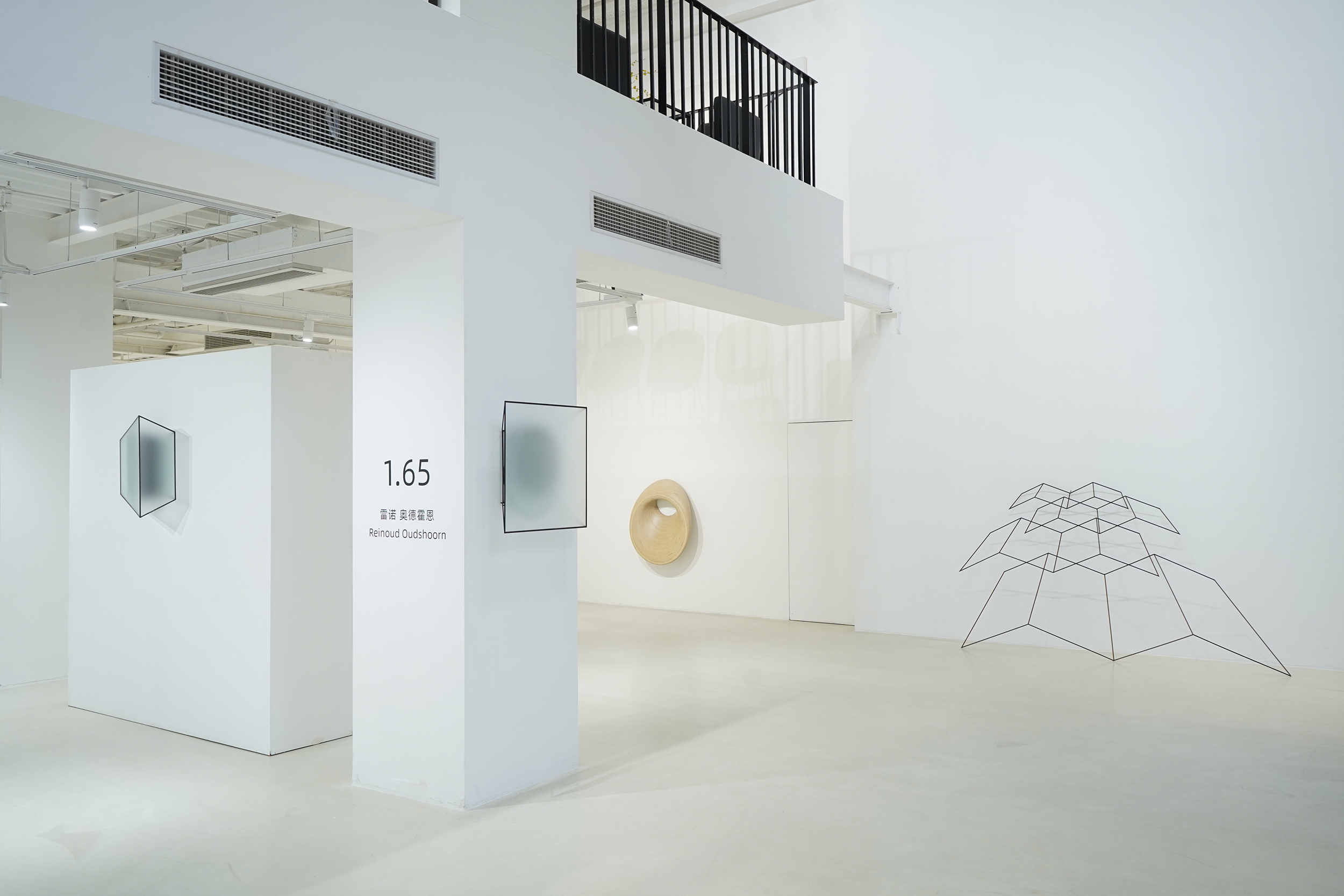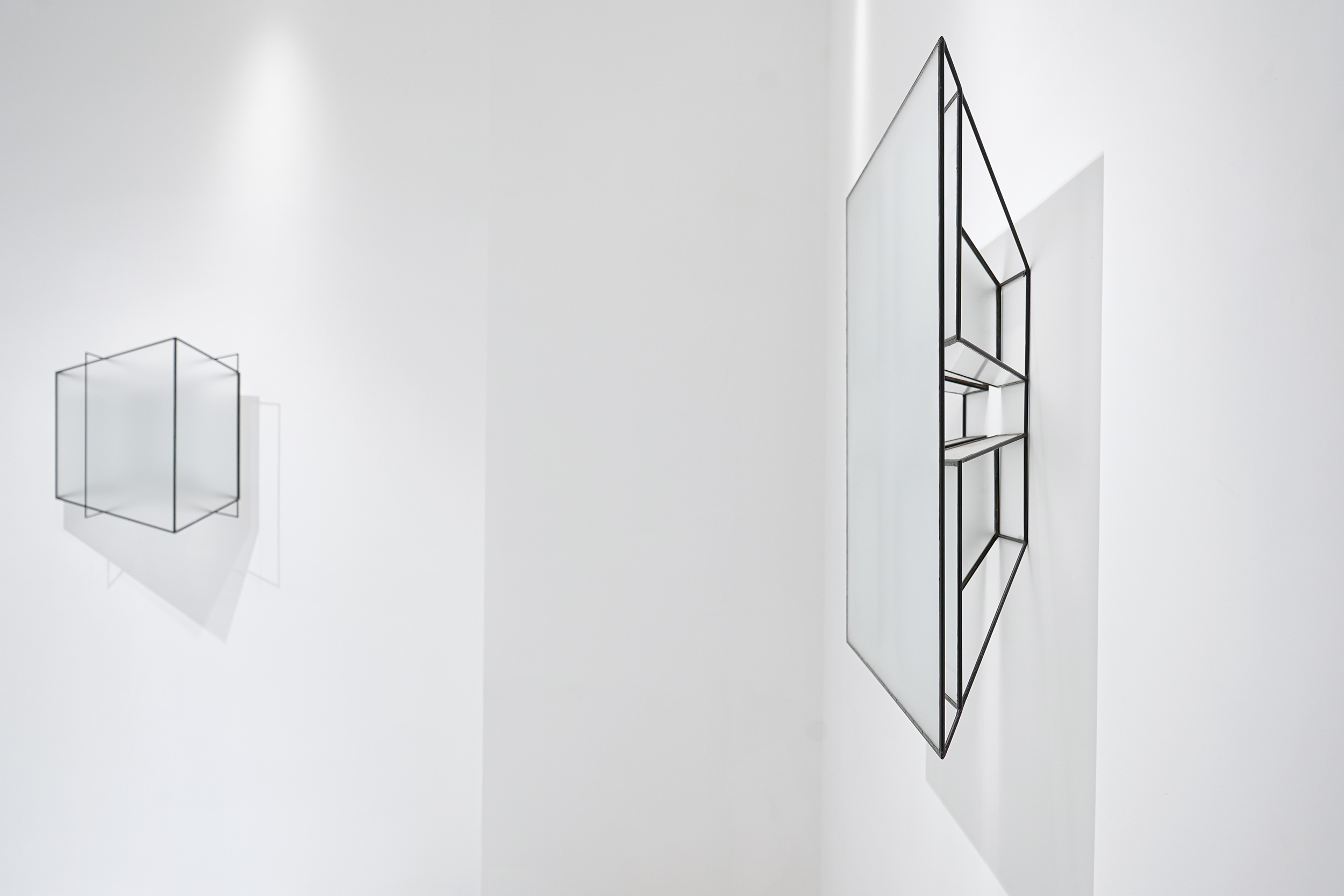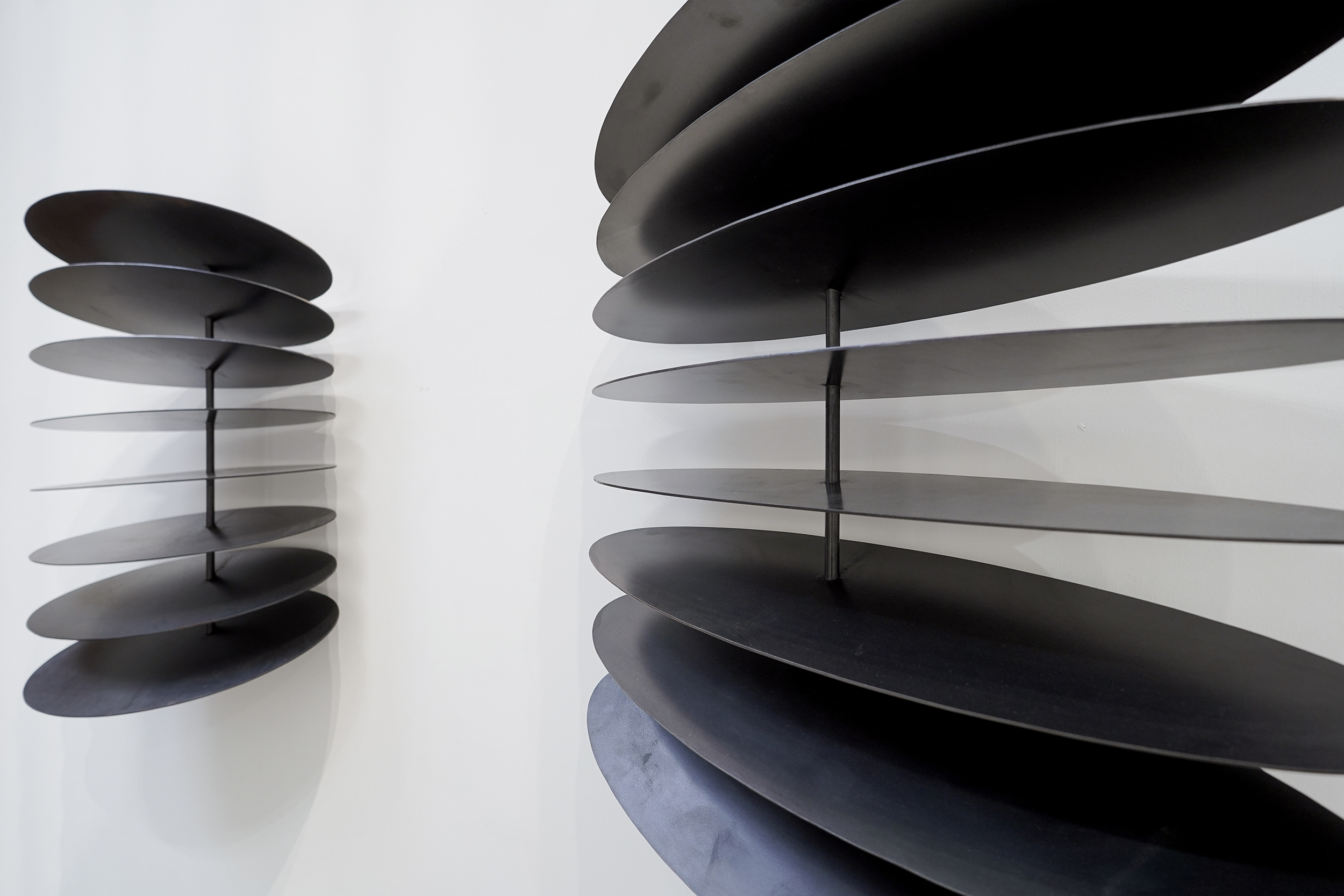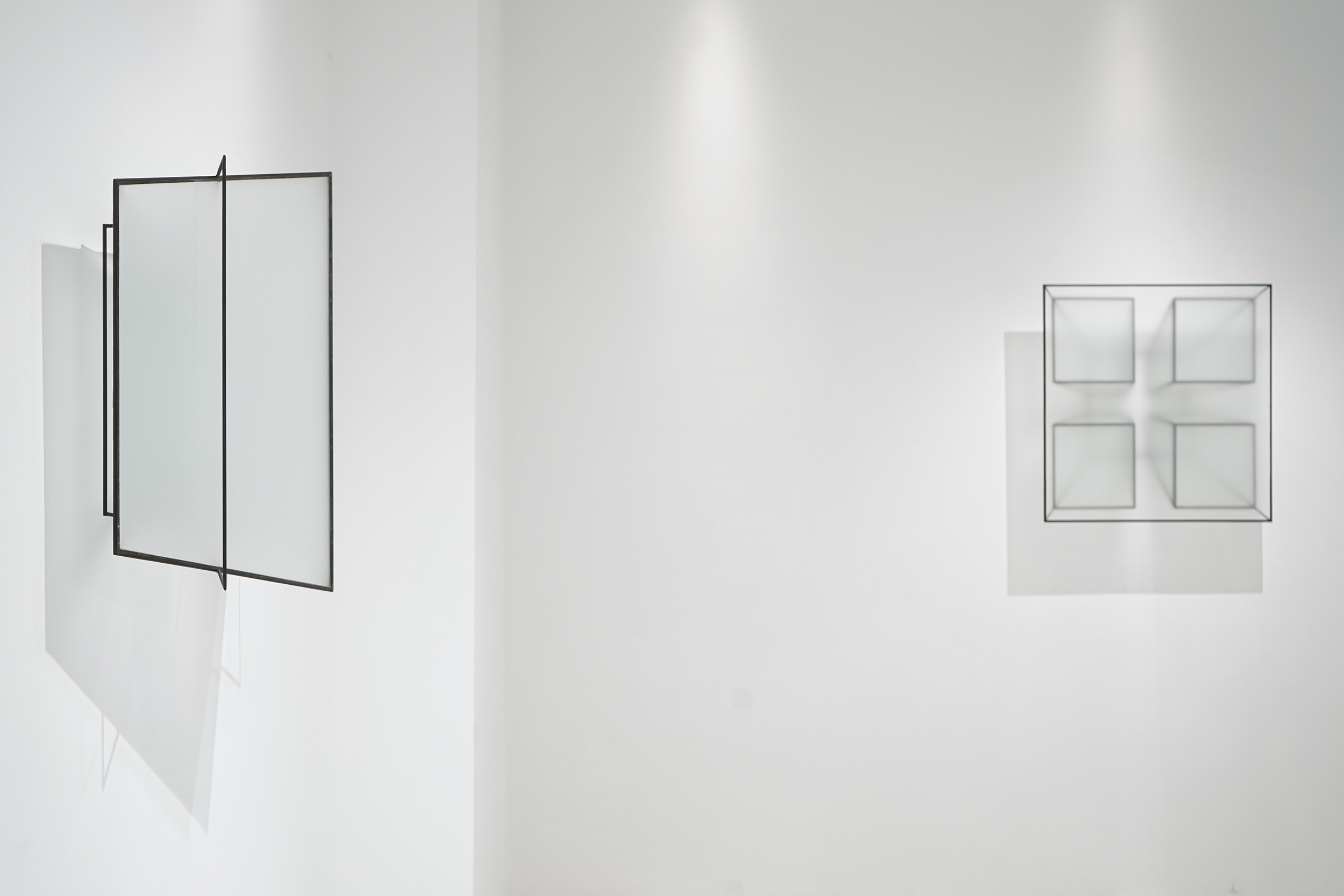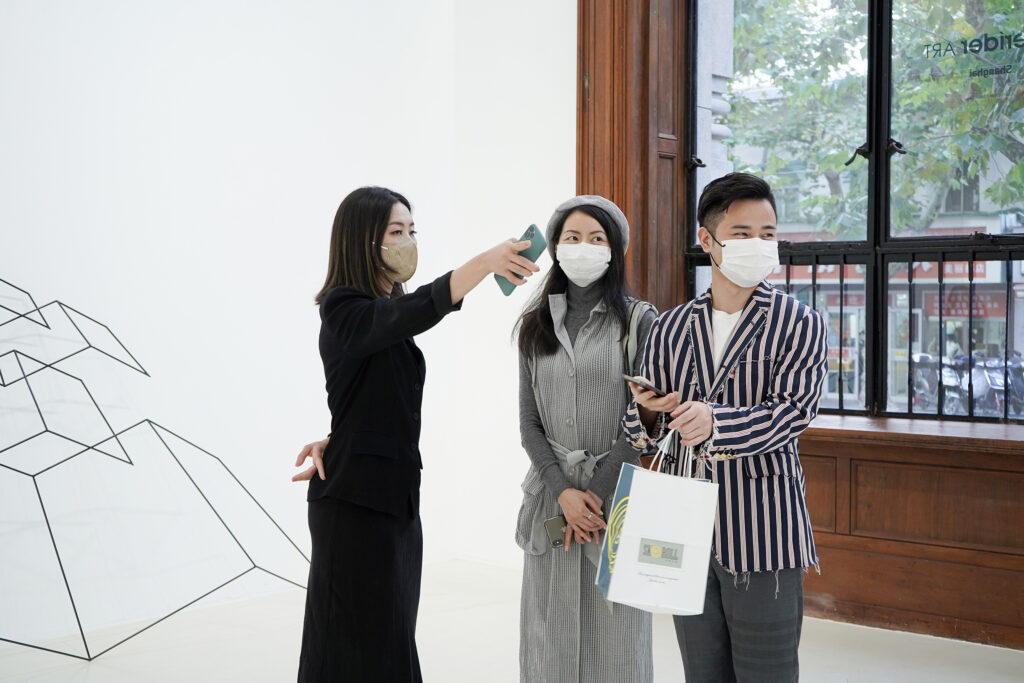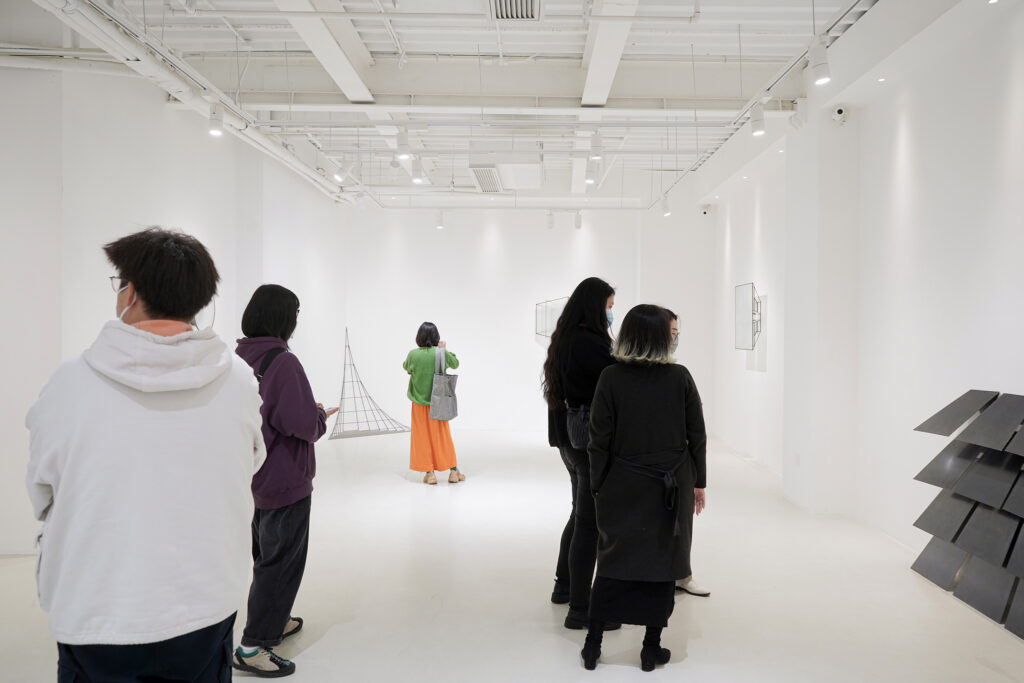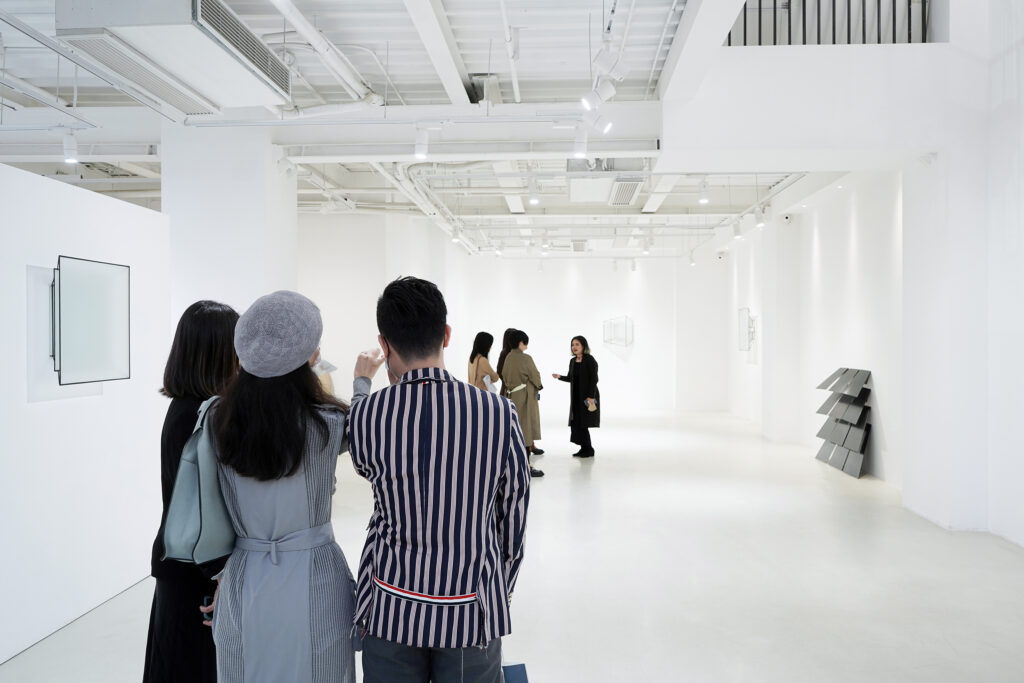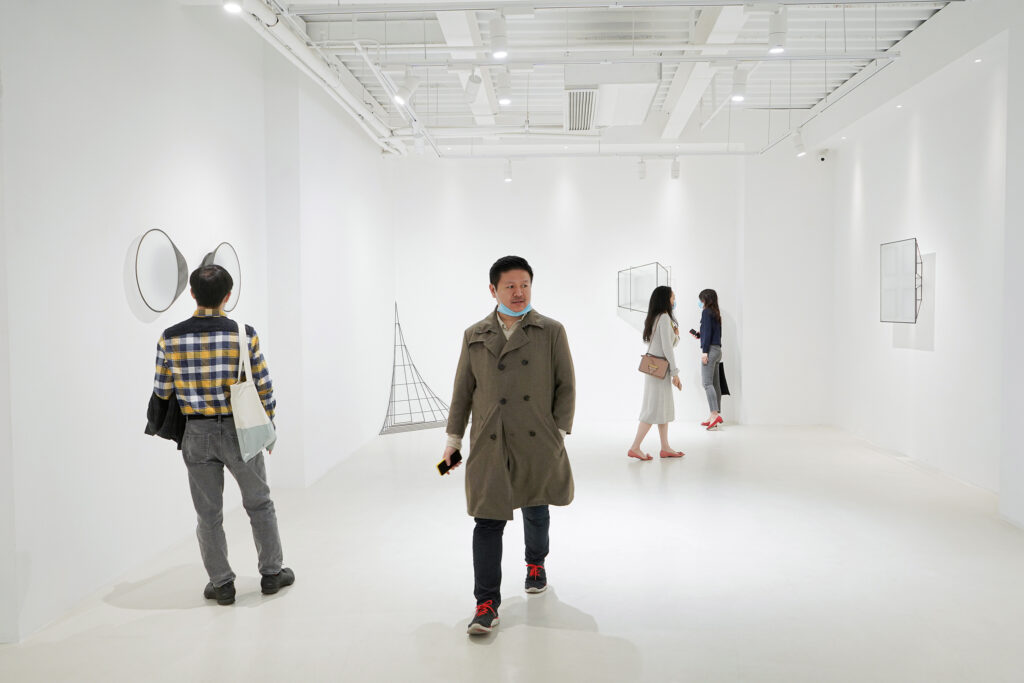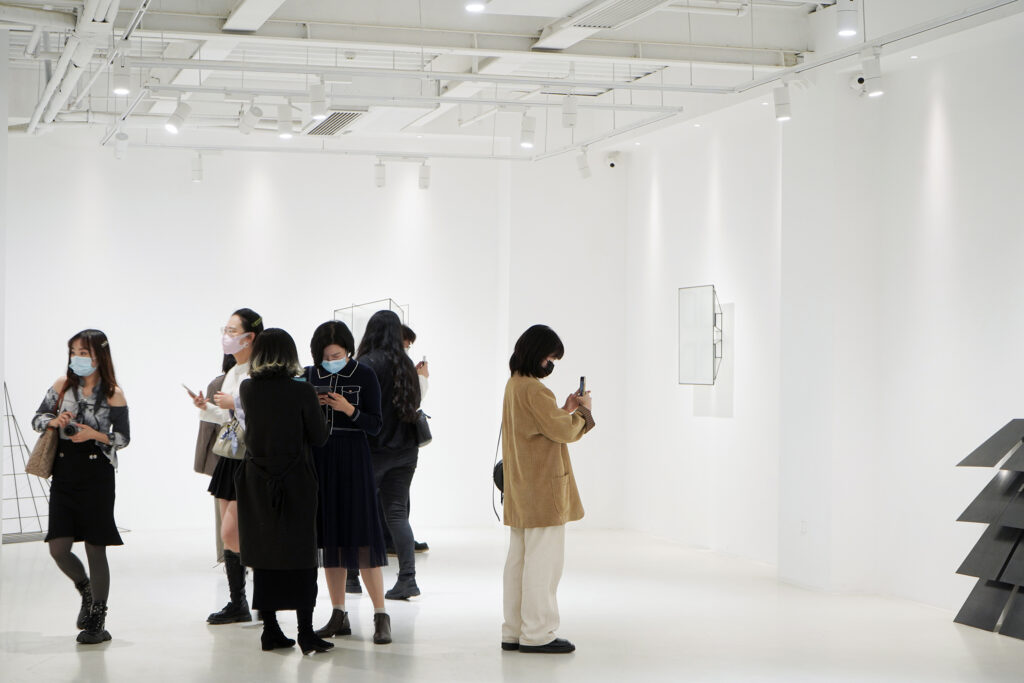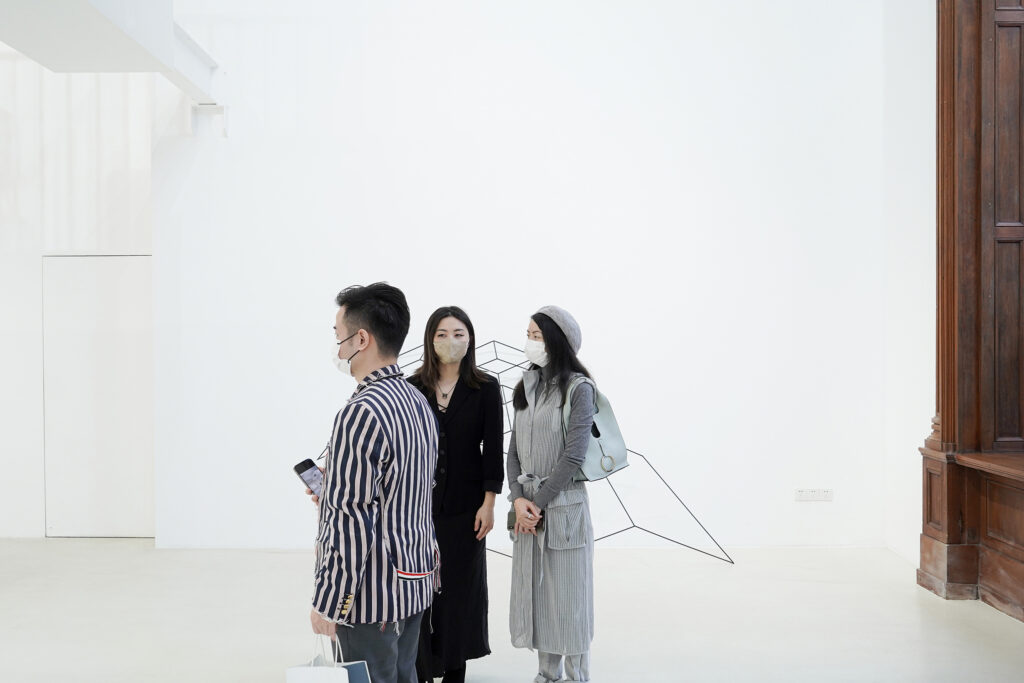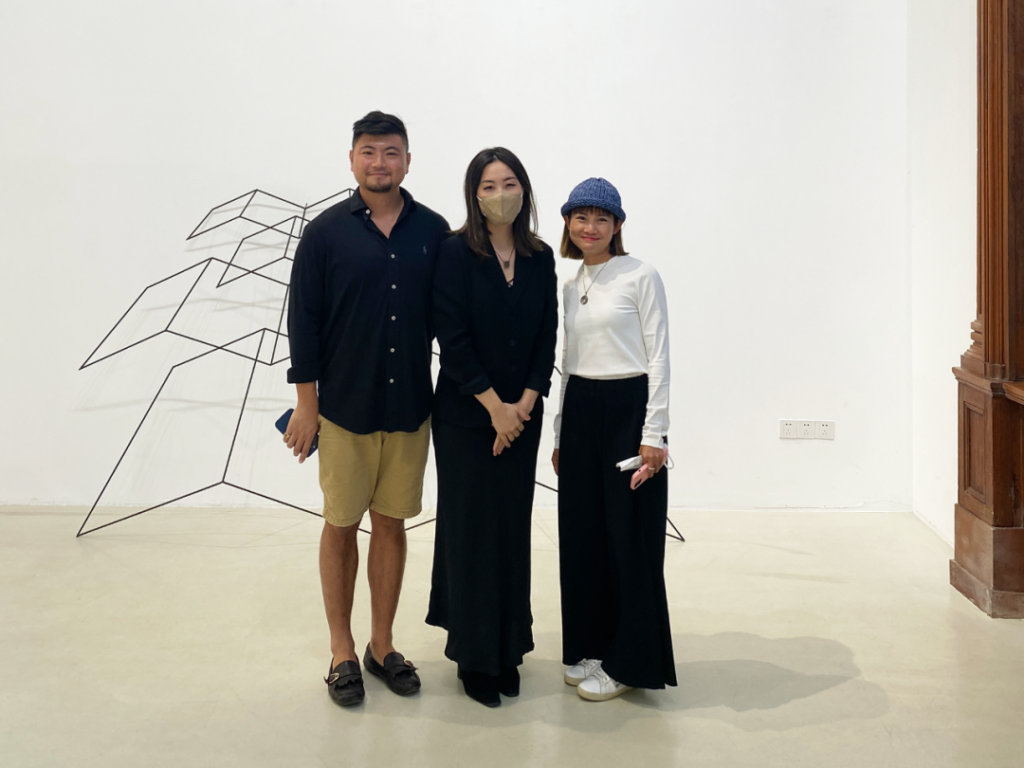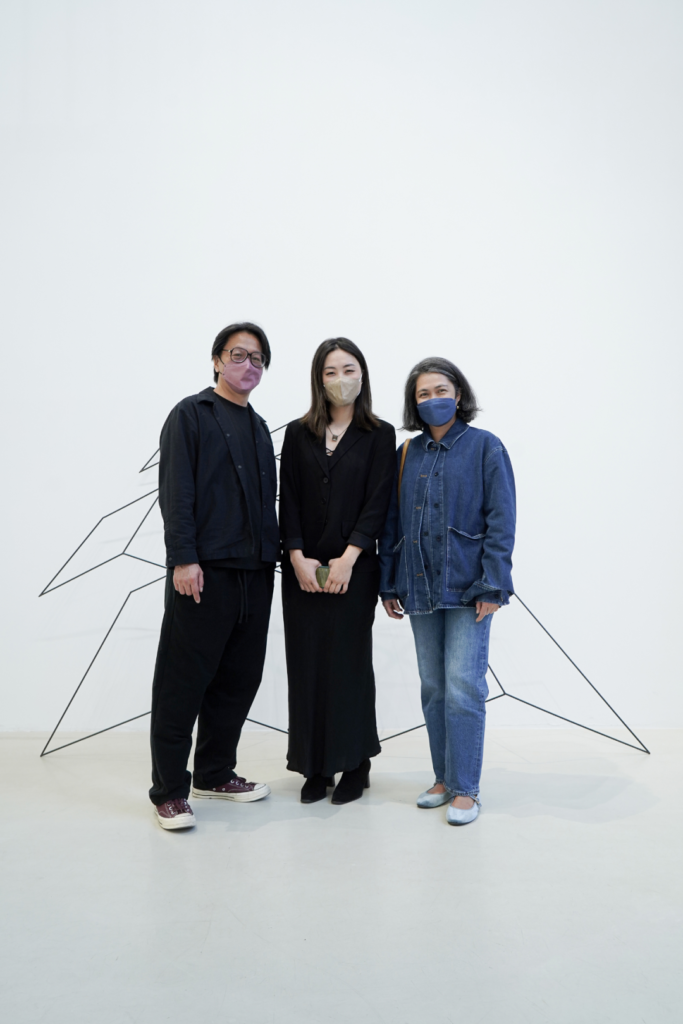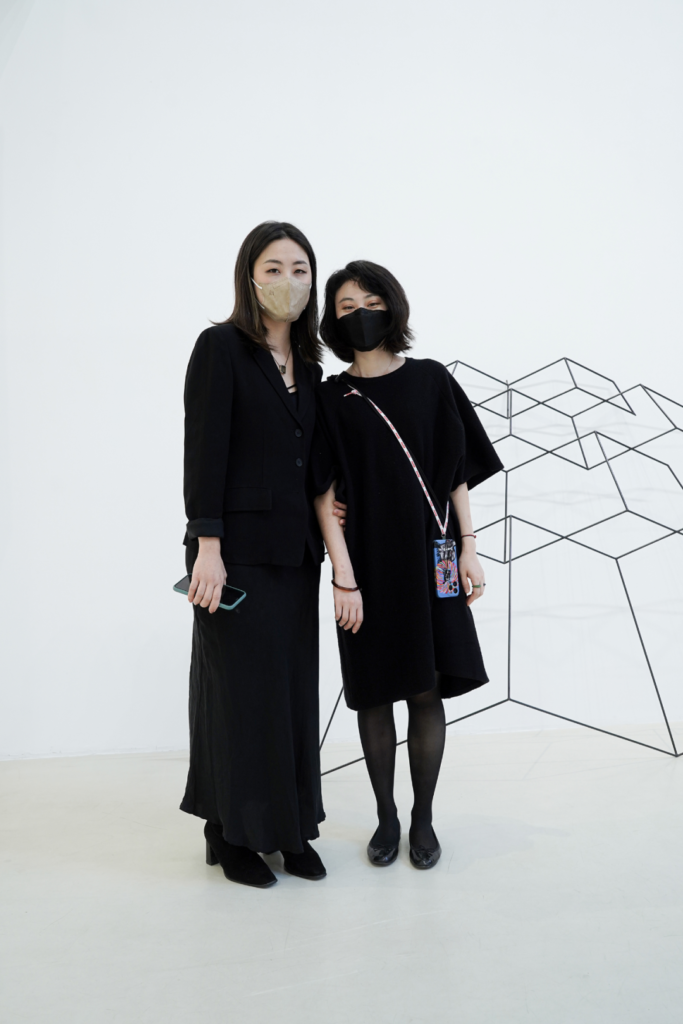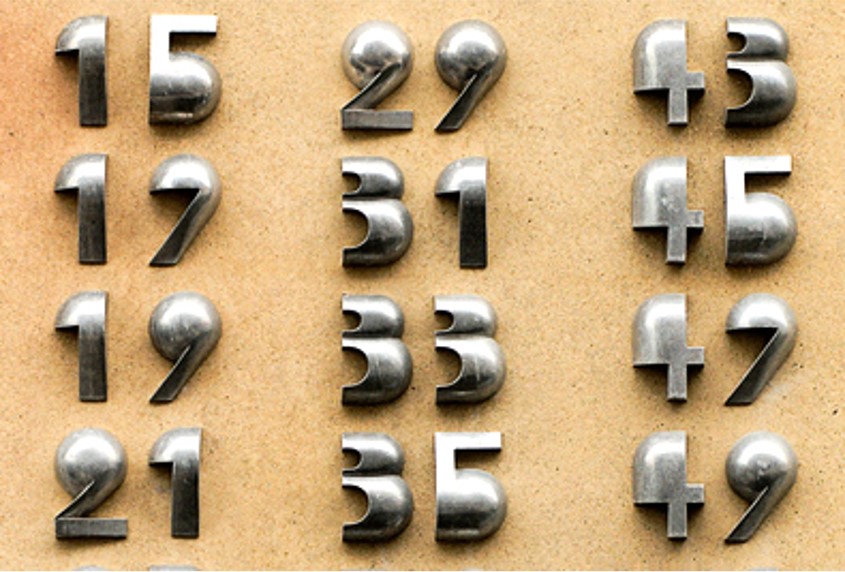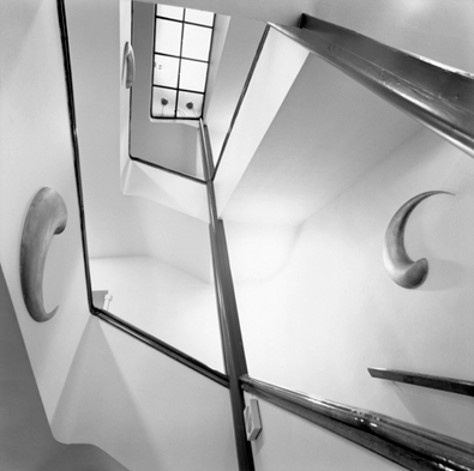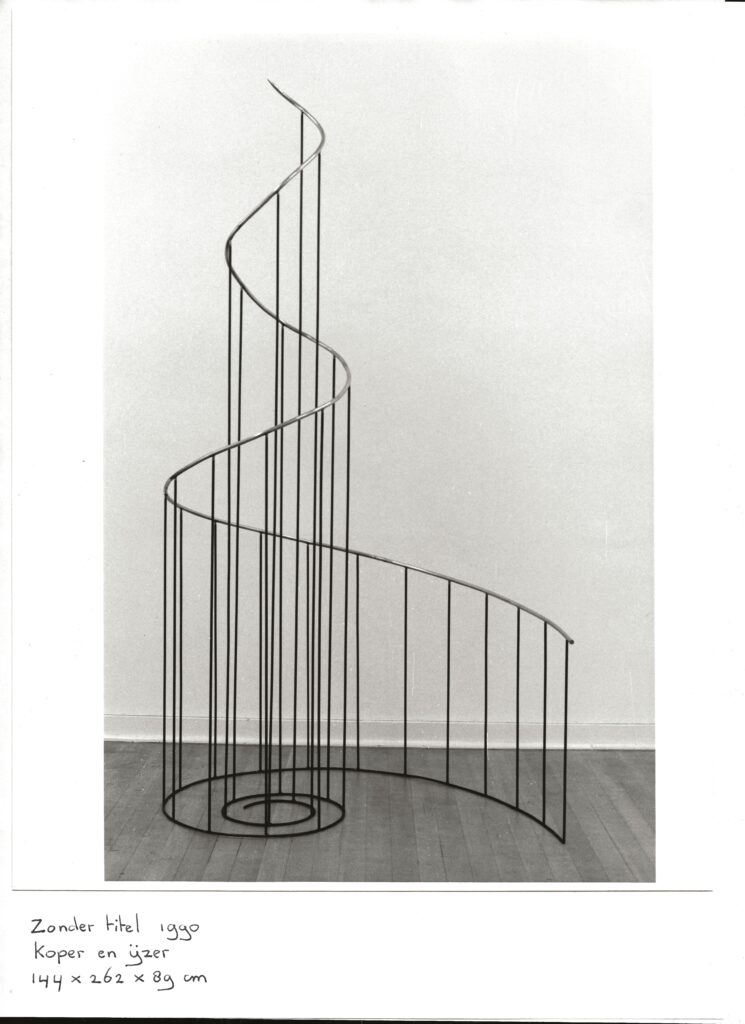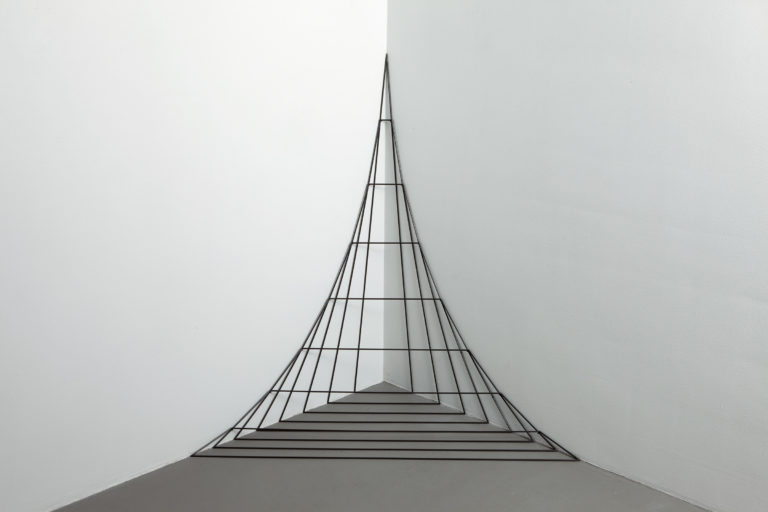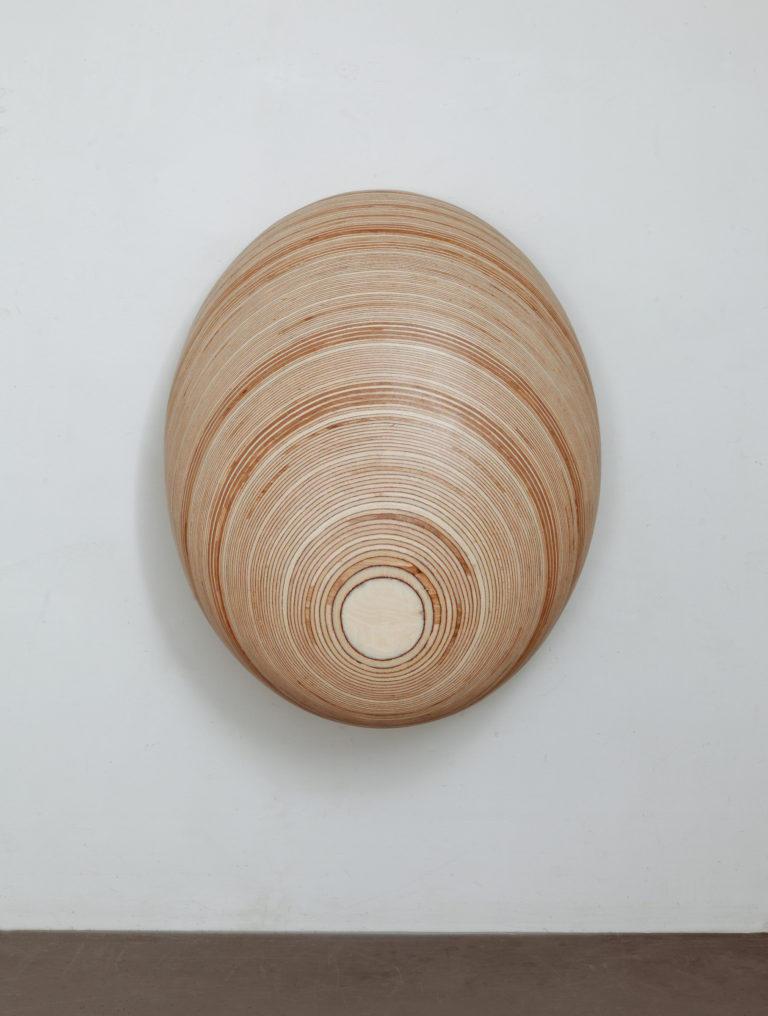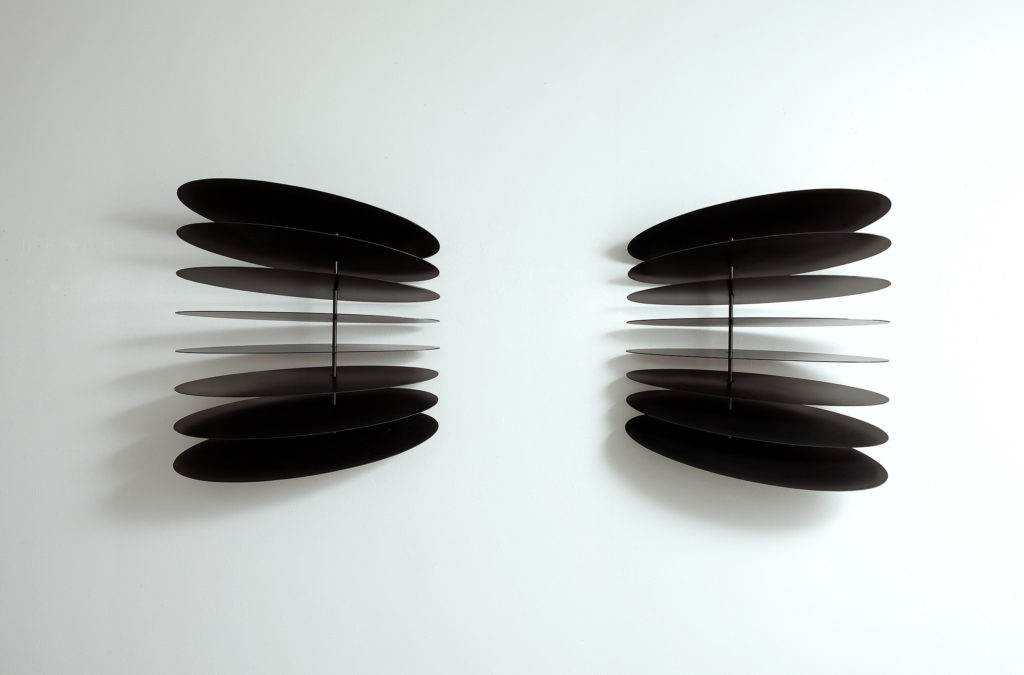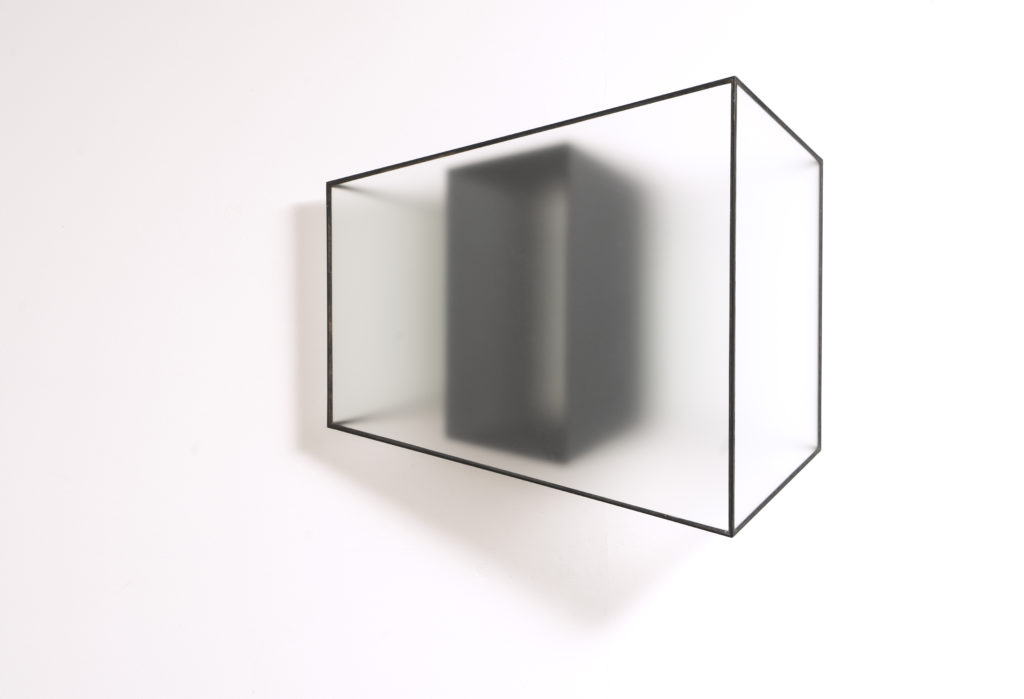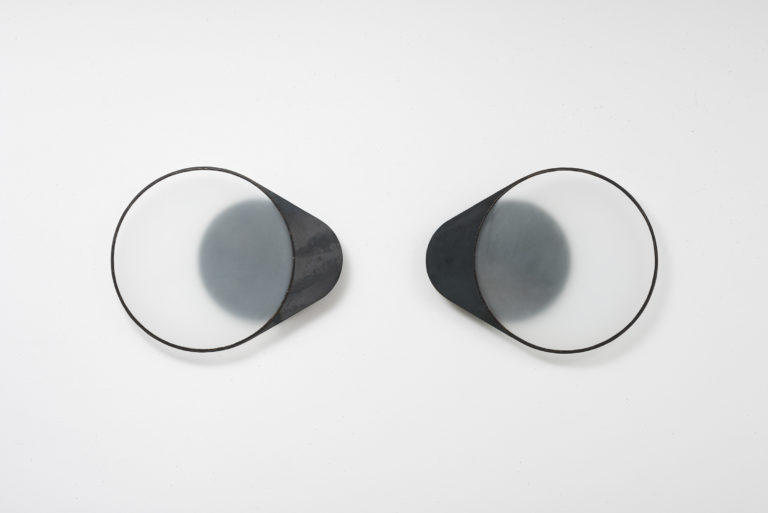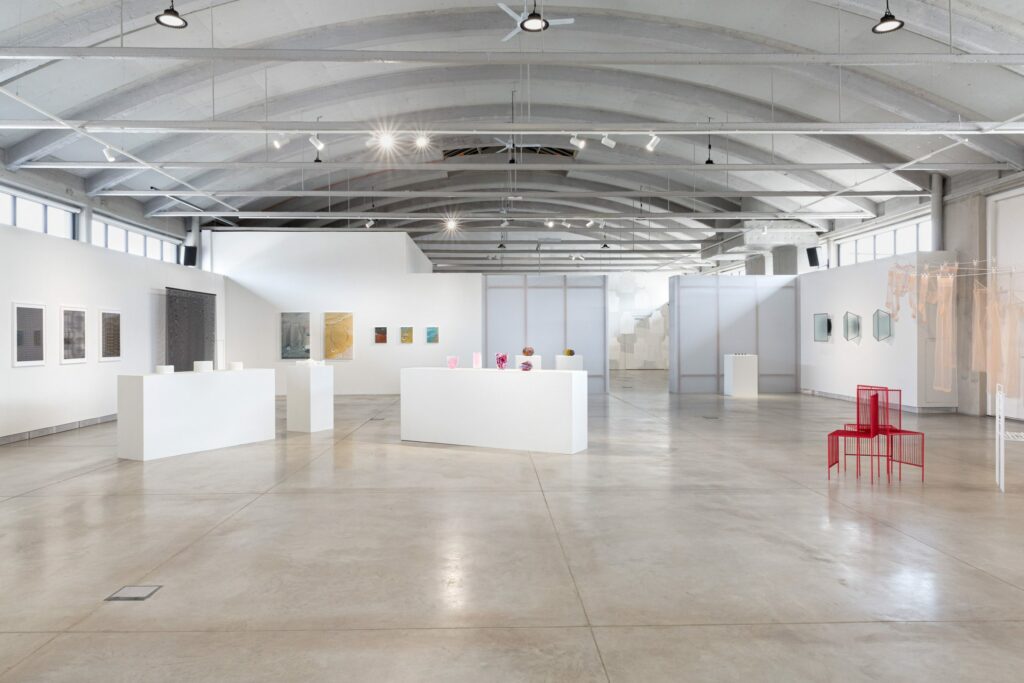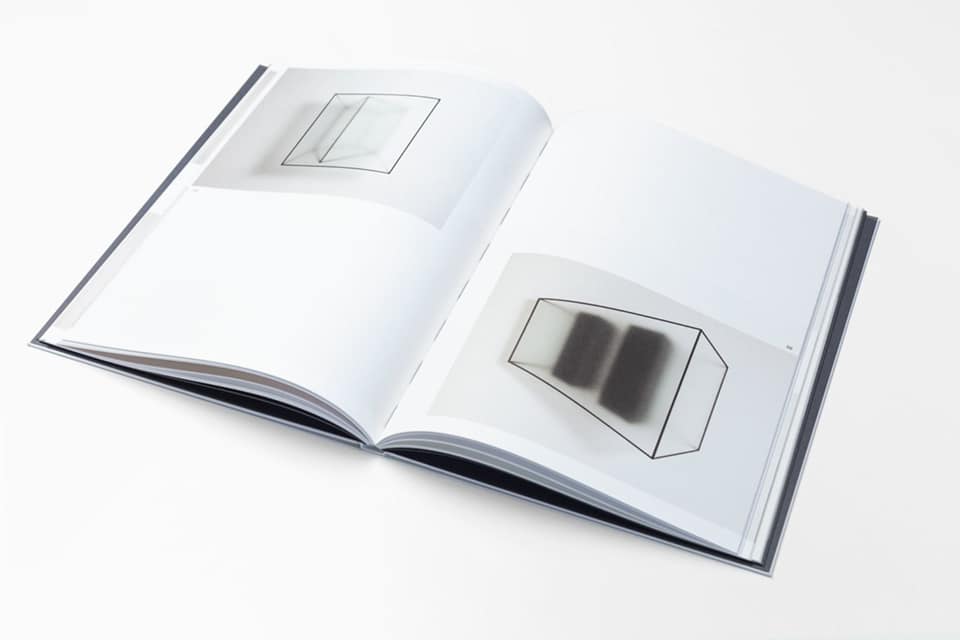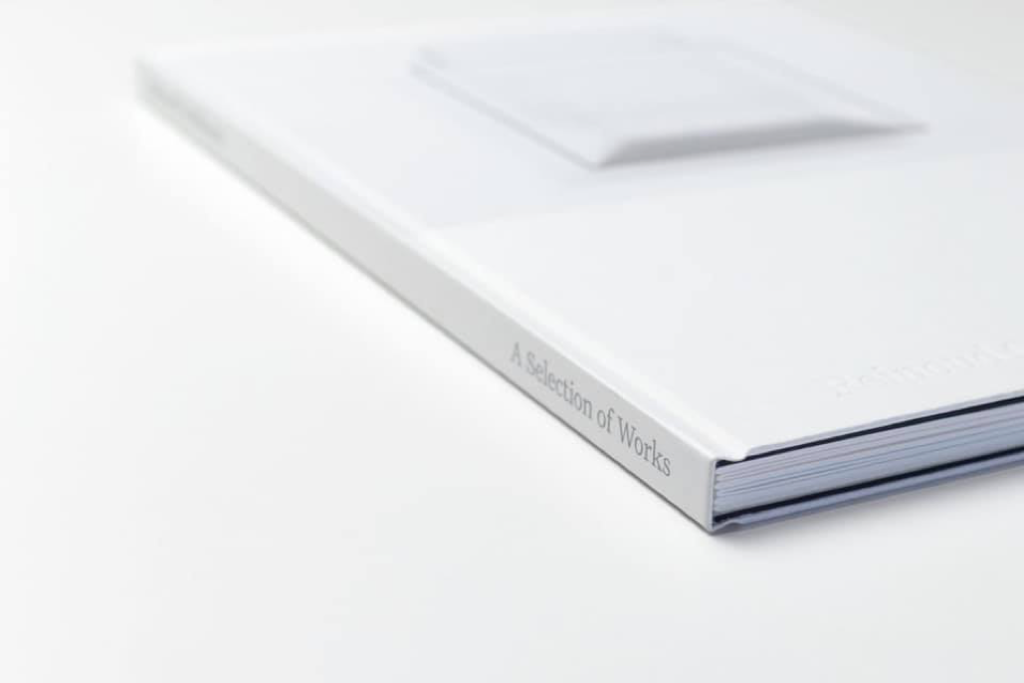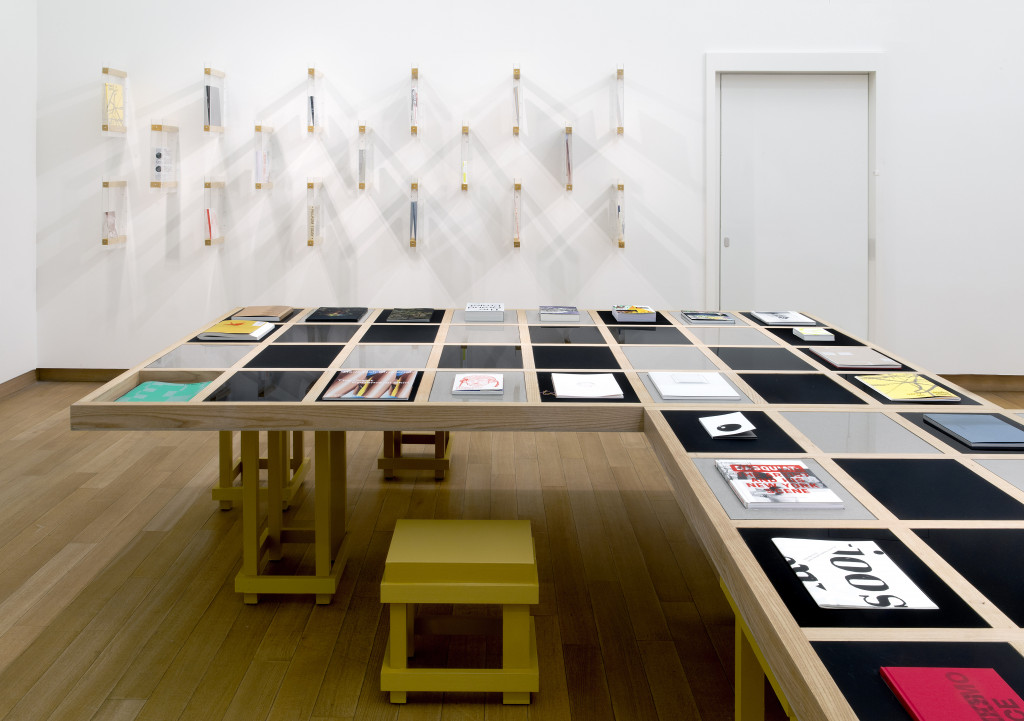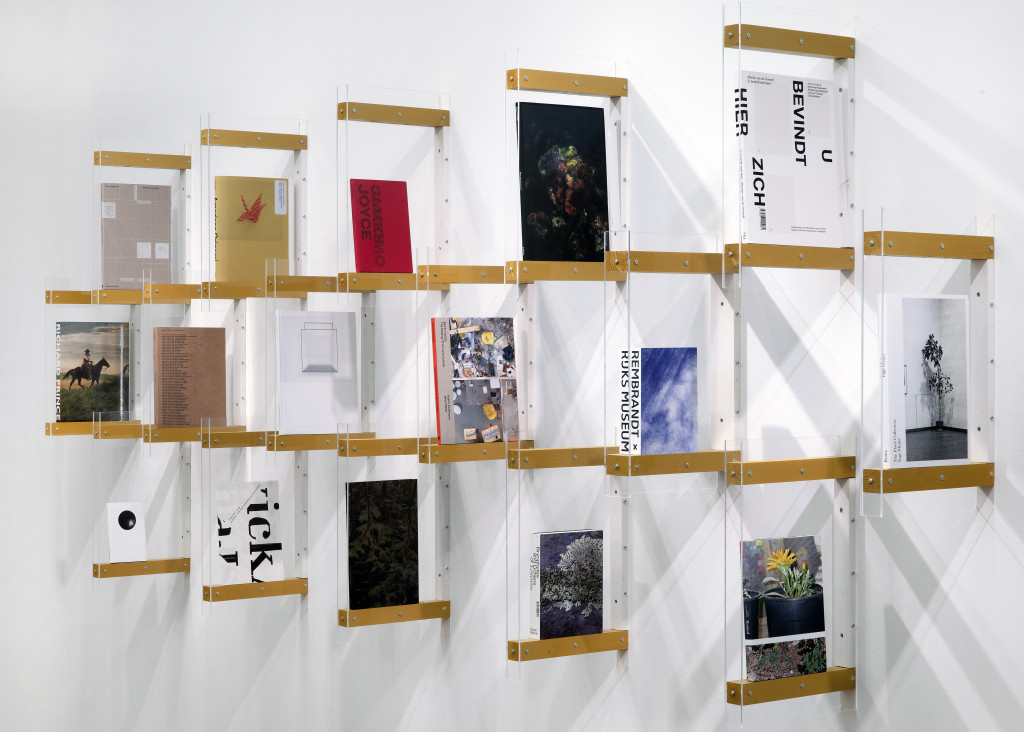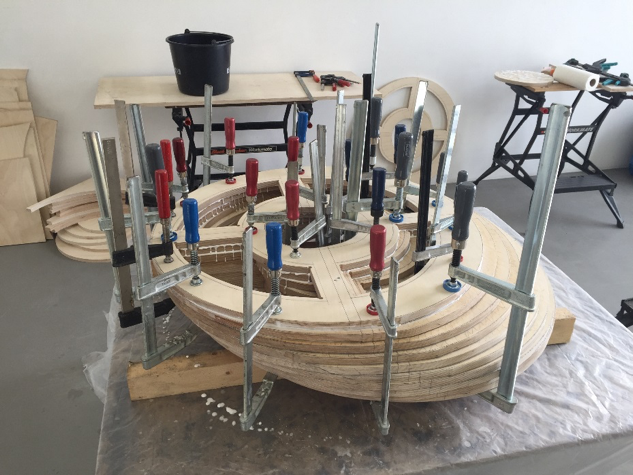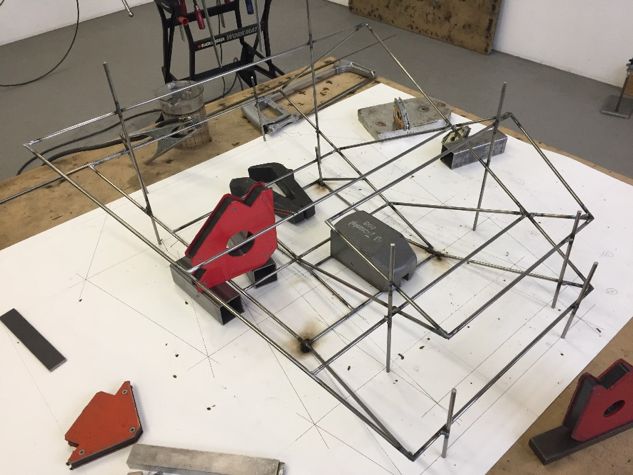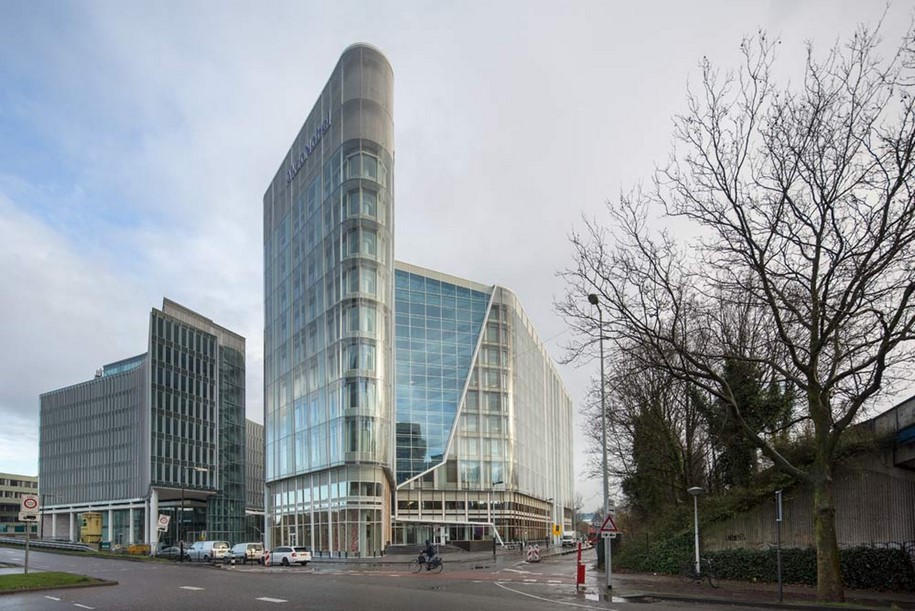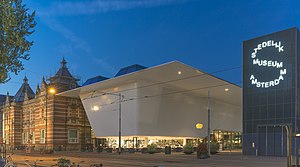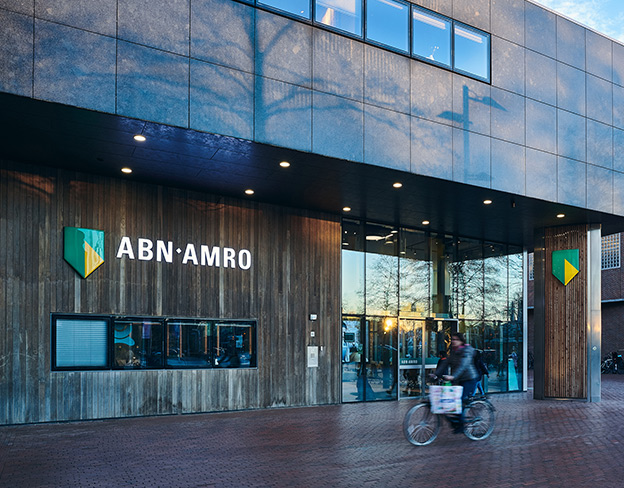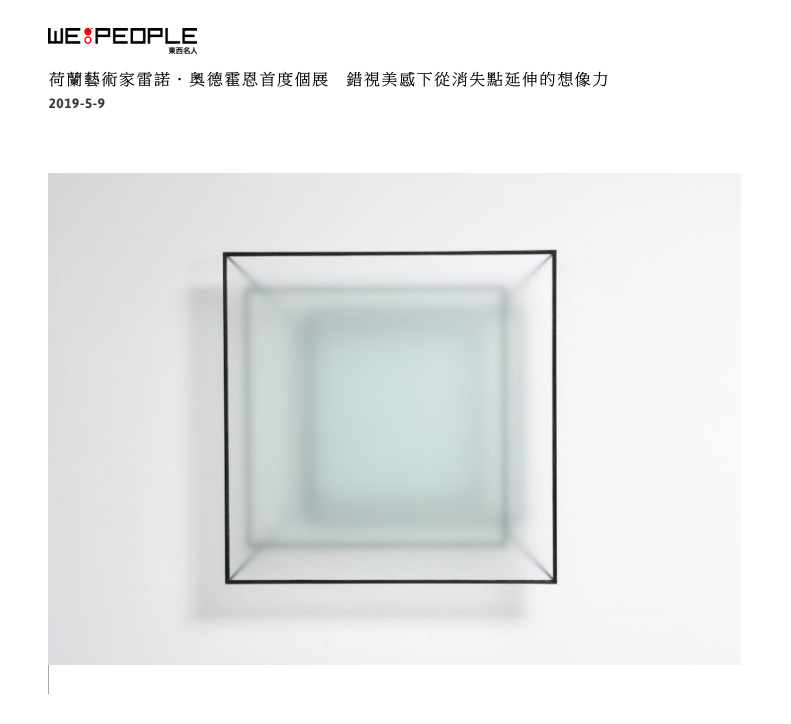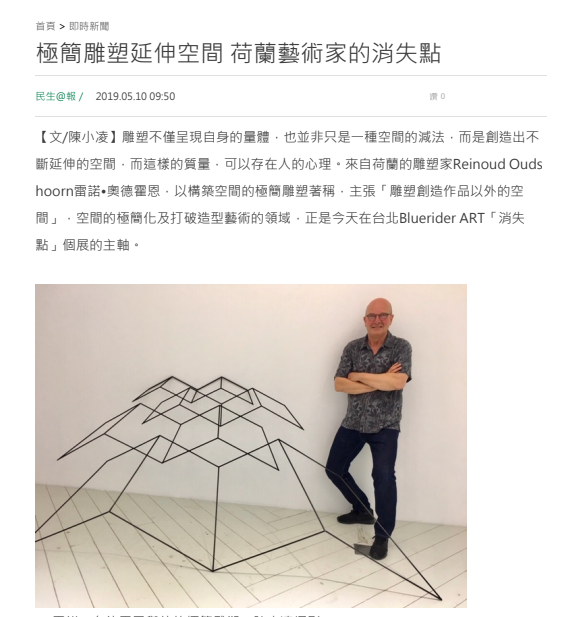Exhibition
Trailer
藝術家訪談影片
導覽影片
Installation
看展Tips提示:
☝️尋找那條沿著展埸1.65米高,看不見的隱形水平線、和消失點
✌️別忘了欣賞那些密密麻麻、數學運算的過程手稿
👌對著窗型作品緩緩地左右走動,發掘霧裡的風景忽隱忽現
p.s. 視覺高度不夠1.65米高,可以櫃臺借小矮櫈
開幕日現場影片
開幕日照片
‘1.65’ — 雷諾·奧德霍恩Reinoud Oudshoorn中國首個展
Bluerider ART 上海・外灘
2022.10.29-12.25
雷諾・奧德霍恩 Reinoud Oudshoorn(荷蘭,b.1953) 荷蘭阿特利爾63學院藝術碩士(MFA, The Ateliers 63 Haarlem),阿爾特茲藝術學士(BFA, AKI School of Arts, Enschede),現居住創作於荷蘭阿姆斯特丹,曾執教於荷蘭皇家藝術學院。雷諾・奧德霍恩 Reinoud Oudshoorn以構築空間的極簡雕塑著稱,認為解決問題是一切創作根源。統一設在1.65M高的滅點(Vanishing Point),從此開啟每件作品的生命裏程,透過單色極簡材質的細膩敘述,點線面多點交錯滅點的獨特語言風格,實現其一貫理念:“我搭起一座始於實體作品、經由透視空間、通往精神世界的橋梁”。展覽經歷遍及歐美,曾於阿姆斯特丹市立博物館(Stedelijk Museum),佛多爾美術館 (Museum Fodor),蘇黎世設計博物館(Museum für Gestaltung)、第8屆愛沙尼亞三年展Tallinn Applied Art Triennal等展出。作品集 ‘A Selection of Works’ 獲評選為‘The Best Dutch Book Designs 2019’。作品獲阿姆斯特丹市立美術館(Stedelijk Musuem Amsterdam)、 荷蘭AkzoNobel Art Foundation、荷蘭銀行(ABN AMRO)、德國私人美術館(Sammlung Schroth)等永久收藏。
With exact mathematical calculation, Oudshoorn draws the perspective of the shape he would create, transforming the work from lines to planes, then from planes to a space according to the distance and the angles of viewing. Ousdhoorn’s sculptures are often made with iron and frosted glass, the latter a symbol of the contemplative, metaphysical and mysterious, atmospherically reminiscent of the muffled silence of mist, and tying in with the artist’s wish to transport a visual image into a space of one’s own imagination.
Oudshoorn’s inspiration for his sculptures originates from impressions of the world the artist experiences. This can be imagery drawn from nature or architectural shapes, and phenomena like the mist characteristic for his homeland. Abstracted into surfaces and structures, they are transformed into new objects that reveal contemplative and even mysterious qualities. This link between nature and infinity refers to influential artistic movements such as the simplified compositions of the De Stijl with its clear forms or to the atmospheric light of Dutch landscape painting. The play with perception and dissolution of forms relates Oudshoorn’s sculptures to works like the condensation cubes by Hans Haake from the early 60s or Anthony Gormley’s cloud chamber Blind Light.


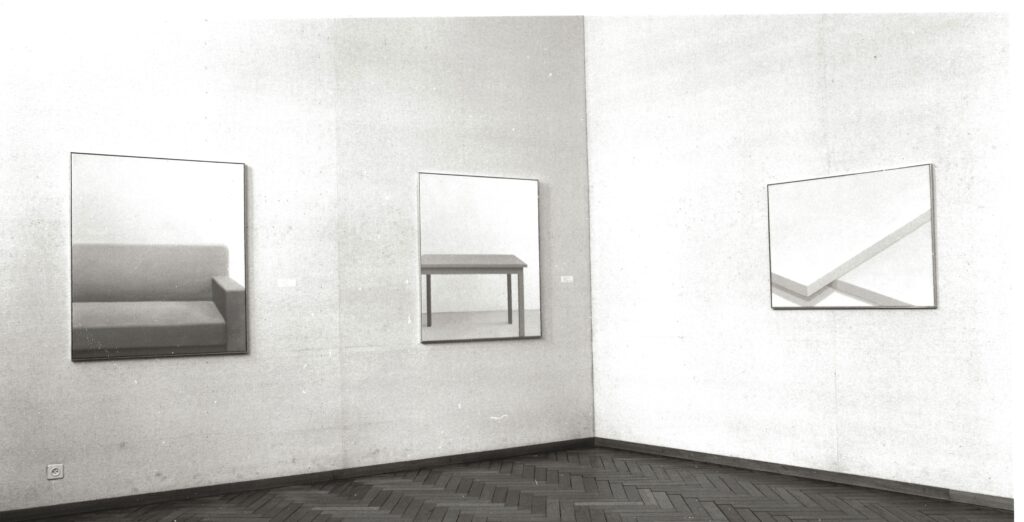
作品於阿姆斯特丹美術館(Stedelijk Museum in Amsterdam )展出 


Oudshoorn’s page in the catalogue, the paintings are from 1973 – 1975
an early work from 1990, A-90, lead on wood 180 x 84 x 84 cm
an early work from 1990, copper and steel 144 x 262 x 89 cm.




Reinoud Oudshoorn| G-21|64x64x22cm| Steel and frosted glass 

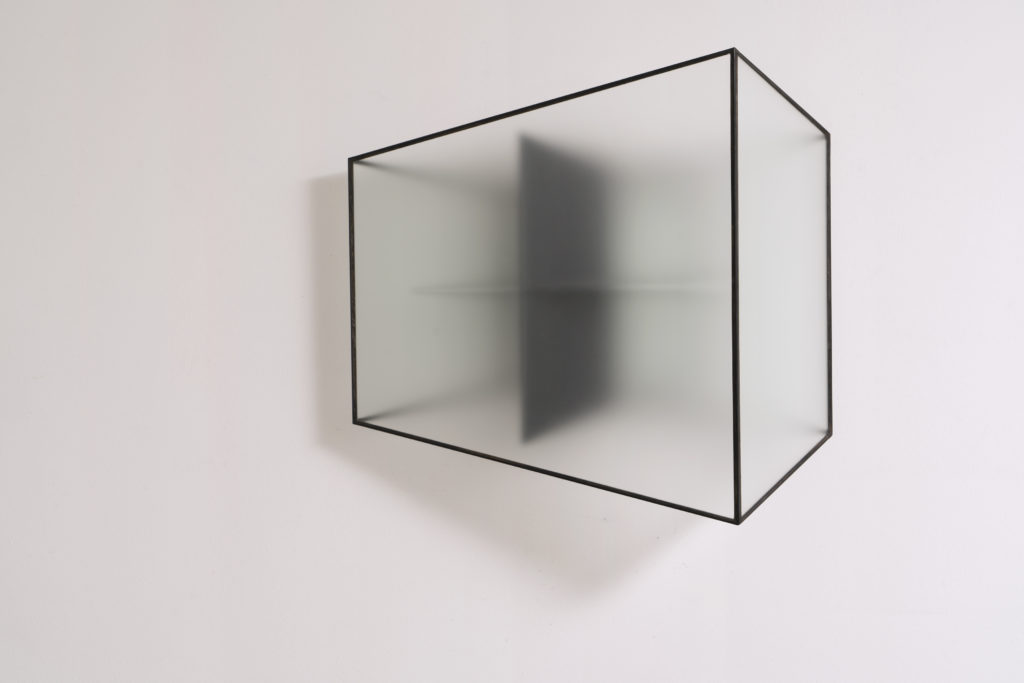
Q-20| 64x70x24cm|Steel and frosted glass
自古羅馬時期藝術家就對透視有一定的認識,兩條並行線在某個點聚集後消失,就是滅點。公元1011年阿拉伯科學家海什木Ibn al-Haytham的《光學全書》Perspectiva翻譯拉丁文就是 “光的科學” 透視(Perspective),文藝復興意大利畫家馬薩喬Masaccio(1401~1428)是第一位在繪畫中使用線性透視,也是第一位在藝術中使用滅點技巧,自此藝術家營造平面繪畫時,為使其具象化的透視手法,任何⻆度觀看都只有一個滅點,將觀者的視線牽引到藝術家想要帶到的位置上,從而達到視覺上的收束。20世紀荷蘭風格派運動(De Stijl)主張抽象和簡化,外形上縮減到幾何形狀,顏色只用紅、黃、藍三原色與黑、白二非色彩的原色。藝術家們共同關心的問題是簡化至本質的藝術元素,平面、直線、矩形成為藝術中的支柱,並通過數學的計算來達到視覺平衡 。奧德霍恩Oudshoorn的作品則開創多維風景,他進壹步將此概念延伸在白墻、地板,創作被定義為一種載體,觀者在接近墻面的那一刻,便可以體驗一種圖像,而這樣的圖像讓空間感變得與眾不同,觀者視覺被牽引至想象滅點,進而打開大腦感官思維,進入想象世界遨翔。
這次於Bluerider ART上海·外灘”1.65”-雷諾・奧德霍恩 Reinoud Oudshoorn 中國大陸首個展,將展出其代表作、最新作品及手稿。展名“1.65”代表1.65M不僅是視覺滅點、消失點,也是打開大腦詩意空間的進入點。整個展埸由一條1.65M高的隱形水平線,串連起每一件展出作品,這些統一1.65M滅點高度的雕塑,每一件又各自擁有墻內延伸空間、墻外拓展空間、腦海中的詩意空間。作品K-10以多件極細黑鐵線條組合,有如鳥羽翅膀淩空飛舞,層層叠叠延伸入⽩墻,宛如一幅空間中的立體繪畫。作品C-21 由12片薄黑鐵片組成,極簡的外型呈現線與⾯的多重延伸、多個滅點,誘發觀眾在移動中,仔細發掘多層次空間的奧妙。展出的藝術家設計手稿,密密麻麻數學計算公式,有如速描作品,呈現藝術家創作思維歷程。


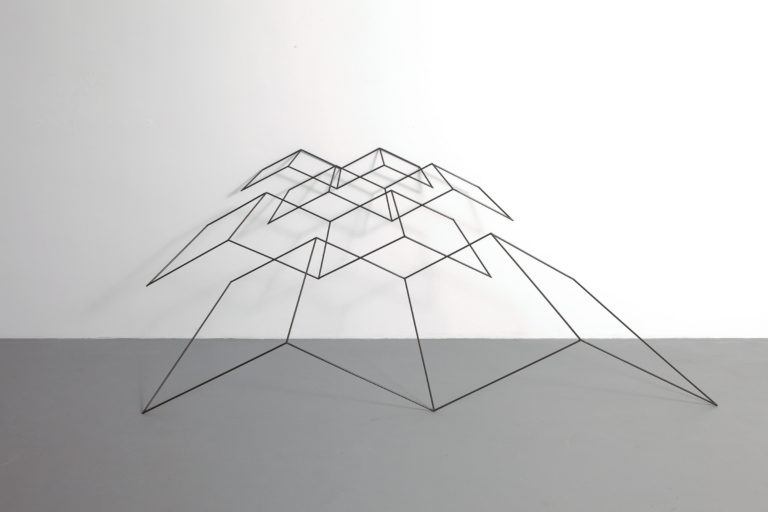
Reinoud Oudshoorn|K-10 | 2010 | 112 x 277 x 109cm | Iron 


Reinoud Oudshoorn|C-21|2021|115x150x24cm|Iron
Oudshoorn's first solo show "Vanishing point" at Bluerider ART revolves around the concept of space and spatial illusion that he had been exploring since long. Space that becomes the concrete reality of a three-dimensional, but also spaces that lie in between the shapes and materials visible; areas that cannot be captured or confined and which remain hidden or obscured. "A sculpture must generate more space than it consumes", stated by Oudshoorn. With limited material and surface, the artist seeks to provide viewers the experience of the totality of space through a relatively small object. He explores the gap between finitude of physical subjects and infinity of immaterial subjects, suggesting an endlessness in the space that surrounds us, an infinity of mind and sphere.
‘1.65’
— 雷諾·奧德霍恩Reinoud Oudshoorn中國首個展
◼️媒體預覽 Press Preview:
10.29 Sat. 2pm – 4pm
◼️VIP Opening開幕式(藏家預覽):
10.29 Sat. 2pm – 5pm
◼️Open to public大眾開放:
10.29 Sat. 5pm – 7pm
◼️展期:
2022.10.29-12.25
◼️地點:
Bluerider ART Shanghai · The Bund
Tuesday to Sunday, 10am-7pm
No. 133 Sichuan Middle Rd., Huangpu Dist., Shanghai
作品 Works
Artist
Reinoud Oudshoorn 雷諾·奧德霍恩
(Netherland, b. 1953)
雷諾・奧德霍恩 Reinoud Oudshoorn(荷蘭,b.1953) 荷蘭阿特利爾63學院藝術碩士(MFA, The Ateliers 63 Haarlem),阿爾特茲藝術學士(BFA, AKI School of Arts, Enschede),現居住創作於荷蘭阿姆斯特丹,曾執教於荷蘭皇家藝術學院。雷諾・奧德霍恩 Reinoud Oudshoorn以構築空間的極簡雕塑著稱,認為解決問題是一切創作根源。統一設在1.65M高的滅點(Vanishing Point),從此開啟每件作品的生命裏程,透過單色極簡材質的細膩敘述,點線面多點交錯滅點的獨特語言風格,實現其一貫理念:“我搭起一座始於實體作品、經由透視空間、通往精神世界的橋梁”。展覽經歷遍及歐美,曾於阿姆斯特丹市立博物館(Stedelijk Museum),佛多爾美術館 (Museum Fodor),蘇黎世設計博物館(Museum für Gestaltung)、第8屆愛沙尼亞三年展Tallinn Applied Art Triennal等展出。作品集 ‘A Selection of Works’ 獲評選為‘The Best Dutch Book Designs 2019’。作品獲阿姆斯特丹市立美術館(Stedelijk Musuem Amsterdam)、 荷蘭AkzoNobel Art Foundation、荷蘭銀行(ABN AMRO)、德國私人美術館(Sammlung Schroth)等永久收藏。
Participating in the 8th Tallinn Applied Art Triennale "Translucency" at Kai Art Center in Estonia in 2021
Stedelijk Museum Amsterdam
With exact mathematical calculation, Oudshoorn draws the perspective of the shape he would create, transforming the work from lines to planes, then from planes to a space according to the distance and the angles of viewing. Ousdhoorn’s sculptures are often made with iron and frosted glass, the latter a symbol of the contemplative, metaphysical and mysterious, atmospherically reminiscent of the muffled silence of mist, and tying in with the artist’s wish to transport a visual image into a space of one’s own imagination.
Oudshoorn’s inspiration for his sculptures originates from impressions of the world the artist experiences. This can be imagery drawn from nature or architectural shapes, and phenomena like the mist characteristic for his homeland. Abstracted into surfaces and structures, they are transformed into new objects that reveal contemplative and even mysterious qualities. This link between nature and infinity refers to influential artistic movements such as the simplified compositions of the De Stijl with its clear forms or to the atmospheric light of Dutch landscape painting. The play with perception and dissolution of forms relates Oudshoorn’s sculptures to works like the condensation cubes by Hans Haake from the early 60s or Anthony Gormley’s cloud chamber Blind Light.



作品於阿姆斯特丹美術館(Stedelijk Museum in Amsterdam )展出 


Oudshoorn’s page in the catalogue, the paintings are from 1973 – 1975
an early work from 1990, A-90, lead on wood 180 x 84 x 84 cm
an early work from 1990, copper and steel 144 x 262 x 89 cm.




Reinoud Oudshoorn| G-21|64x64x22cm| Steel and frosted glass 


Q-20| 64x70x24cm|Steel and frosted glass
Oudshoorn's first solo show "Vanishing point" at Bluerider ART revolves around the concept of space and spatial illusion that he had been exploring since long. Space that becomes the concrete reality of a three-dimensional, but also spaces that lie in between the shapes and materials visible; areas that cannot be captured or confined and which remain hidden or obscured. "A sculpture must generate more space than it consumes", stated by Oudshoorn. With limited material and surface, the artist seeks to provide viewers the experience of the totality of space through a relatively small object. He explores the gap between finitude of physical subjects and infinity of immaterial subjects, suggesting an endlessness in the space that surrounds us, an infinity of mind and sphere.
Reinoud Oudshoorn's creative manuscript
收藏紀錄 Collection
Press

 Tekst Hans Sizoo
Tekst Hans Sizoo


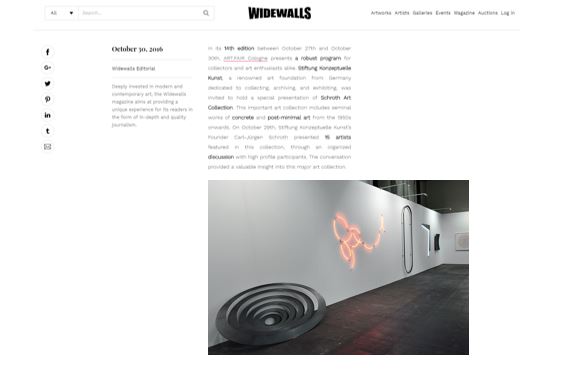 Wide Walls
Wide Walls
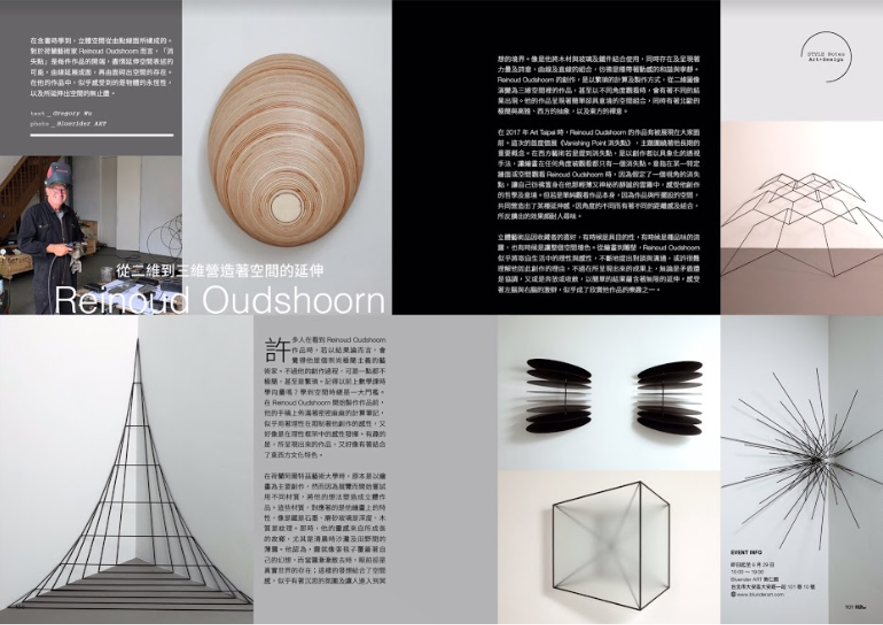 Style Master
Style Master
Reinoud Oudshoorn
(Netherland, b. 1953)
Solo Exhibition
2020 Fragmented Truth (with Alice Quaresma), Patrick Heide Contemporary Art, London
2019 Vanishing Point,Bluerider ART, Taipei, Taiwan
2017 Dimensions of three, Allouche Gallery, New York, US
2017 Recent Sculptures, Patrick Heide Art Company, London, UK
2015 Ramakers Gallery, The Hague, The Netherlands
2013 Recent Sculptures, Patrick Heide Art Company, London, UK
2012 Dimensions, Gallery Skape, Seoul, South Korea
2011 Wetering Gallery, Amsterdam, The Netherlands
2010 Poetic reality in space, Gallery Skape, Seoul, South Korea
2009 Wetering Gallery, Amsterdam, The Netherlands
2008 Art Amsterdam, Wetering Gallery, Amsterdam, The Netherlands
2008 Wetering Gallery, Amsterdam, The Netherlands
2005 Wetering Gallery, Amsterdam, The Netherlands
2003 Wetering Gallery, Amsterdam, The Netherlands
2000 Wetering Gallery, Amsterdam, The Netherlands
1998 Wetering Gallery, Amsterdam, The Netherlands
1996 Wetering Gallery, Amsterdam, The Netherlands
1995 Wetering Gallery, Amsterdam, The Netherlands
1994 Path Gallery, Aalst, Belgium
1993 Wetering Gallery, Amsterdam, The Netherlands
1992 Wetering Gallery, Amsterdam, The Netherlands
1991 Path Gallery, Aalst, Belgium
1990 Wetering Gallery, Amsterdam, The Netherlands
1988 Waalkens Gallery, Finsterwolde, The Netherlands
1987 Wetering Gallery, Amsterdam, The Netherlands
1985 Wetering Gallery, Amsterdam, The Netherlands
1983 Wetering Gallery, Amsterdam, The Netherlands
1981 Wetering Gallery, Amsterdam, The Netherlands
1979 Museum Fodor, Amsterdam, The Netherlands
1978 Waalkens Gallery, Finsterwolde, The Netherlands
Group Exhibition
2022 The Blue Danube, Bluerider ART ,Shanghai , China
2021 Mental Space,Bluerider ART ,Taipei. , Taiwan
2020 For the Love of Art Part 1and 2, Gallery Ramakers, The Hague
2020 Gallery Ramakers at Art Rotterdam.
2019 Uit het atelier, Gallery Ramakers, The Hague, The Netherlands
2018 3D “Schrift am Bau”, Museum für Gestaltung, Zürich, Switzerland
2018 Volta NY, Allouche Gallery, New York, USA
2017 Machinerie, Proviciehuis, Haarlem, The Netherlands
2017 Art Rotterdam, Ramakers Gallery, The Netherlands
2017 Art Geneva, Patrick Heide, Geneva, Switzerland
2016 PULSE Miami, Patrick Heide, Miami, USA
2016 Shall I compare thee to a summer’s day, Ramakers Gallery, The Hague, The
Netherlands
2016 Grand opening new space” Gallery Allouche Gallery, New York, USA
2016 Volta Basel, Patrick Heide, Basel, Switzerland
2016 Konstruction Construction, Museum Sammlung Schroth, Soest, Germany
2016 Art Geneva, Patrick Heide, Geneva, Switzerland
2016 Licht en transparantie, Thomas Elshuis en Reinoud Oudshoorn, Nieuw
Dakota, Amsterdam, The Netherlands
2016 Ramakers Gallery, The Hague, The Netherlands
2015 Patrick Heide Gallery on the Miami Pulse, Miami, USA
2015 A call for drawing, Symposium, HKU, Utrecht, The Netherlands
2015 Volta Basel, Patrick Heide Gallery, Basel, Switzerland.
2014 PULSE Miami, Patrick Heide Gallery, Miami, USA
2014 Nanjing International Art Festival, Nanjing, China.
2014 Short-hand-made, Grindel 117, Hamburg. Germany.
2014 20 years anniversary, Ramakers Gallery, The Hague, The Netherlands
2014 Volta Basel, Patrick Heide Gallery, Basel, Switzerland.
2013 PULSE Miami, Patrick Heide Gallery, Miami, USA
2013 Hidden dimension, Gallery Skape, Seoul, South Korea.
2013 The last picture show, Wetering Gallery, Amsterdam, The Netherlands
2013 Hidden dimension, Gallery Skape, Seoul, South Korea
2013 Capriccio, JCA de KOK centre for contemporary art, The Hauge, The
Netherlands
2013 Reinoud Oudshoorn and Jérôme Touron, Ramakers Gallery, The Hauge, The
Netherlands
2012 PULSE Miami, Patrick Heide Gallery, Miami, USA
2012 Gallery Skape, Gallery Seoul Art Fair, Seoul, South Korea
2011 PULSE Miami, Patrick Heide Gallery, Miami, USA
2011 Permanent Exibition, Skape Gallery, Seoul, South Korea
2010 PULSE Miami, Patrick Heide Gallery, Miami USA
2010 Space A 2010, Gallery Space, Seoul, South Korea
2008 Ten Feet De Vishal, Haarlem, The Netherlands
2007 De keuze van Lucassen Ramakers Gallery, The Hague
2006 Façade Arti et Amicitiae, Amsterdam, The Netherlands
2001 A Public Space 2001 Odyssey Arti et Amicitiae, Amsterdam, The Netherlands
1997 Nooit zag ik Awater zo nabij Oude Kerkje, Kortenhoef, The Netherlands
1997 One Line Drawing, Ubu Gallery, New York, USA
1996 The Dutch Connection Marshall Art Gallery, Memphis TN, USA
1996 Weatherview Norwich Gallery, Norwich, UK
1994 The Collection Stedelijk Museum, Amsterdam, The Netherlands
1994 De keuze van Betty van Garrel Wetering Gallery, Amsterdam, The
Netherlands
1993 Atelier Mémoire, Paris, France
1993 20 Years Wetering Gallery Wetering Gallery, Amsterdam, The Netherlands
1993 Kai,Sagaert et Oudshoorn Atelier Mémoire, Paris, France
1992 Le Génie de la Bastille Paris, France
1992 Gemeente Kunstaankopen 1991 Museum Fodor, Amsterdam, The Netherlands
1990 Liberations Jewish Historical Museum, Amsterdam, The Netherlands
1989 Kunstlijn Sculpture Route Zwolle-Emmen, The Netherlands
1989 AMRO Bank Collection, A Choice Stedelijk Museum, Amsterdam, The
Netherlands
1988 Spiel der Uberraschungen der Europaïschen Kunst des 20 Jahrhundert,
Bochholt, Germany
1986 KunstRai, Wetering Gallery, Amsterdam, The Netherlands
1984 De Kampanje, Den Helder, The Netherlands
1981 Felison op Beeckestijn, with Marlene Dumas, Velzen Zuid, The Netherlands
1979 Van Krimpen Gallery, Amsterdam, The Netherlands
1976 11 Painters, Stedelijk Museum, Amsterdam, The Netherlands
1975 Markt 17, Enschede, The Netherlands
1974 Rijksmuseum Twente, Enschede, The Netherlands
Collections
Akzo Nobel Art Foundation
Collection Stedelijk Museum, Amsterdam
ABN AMRO Art Collection
The Chadha Art Collection
Eleanore De Sole Collection
Joods historisch museum
University Medical Center Utrecht
Collection Sammlung Schroth, Germany


